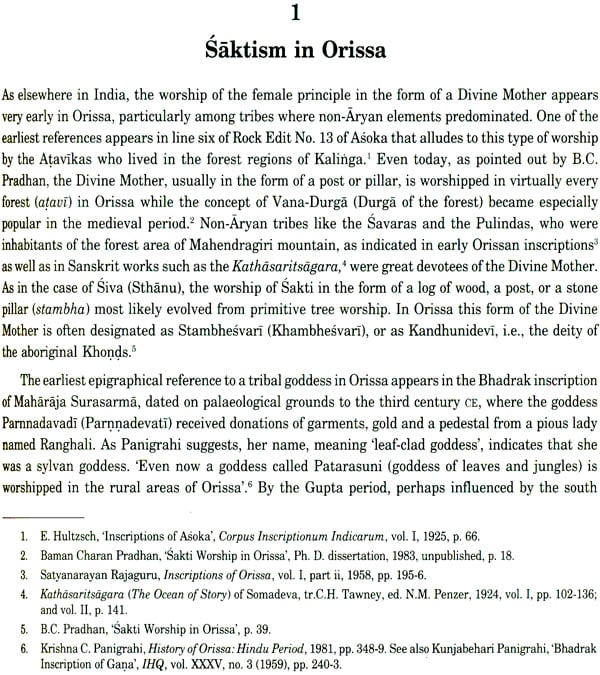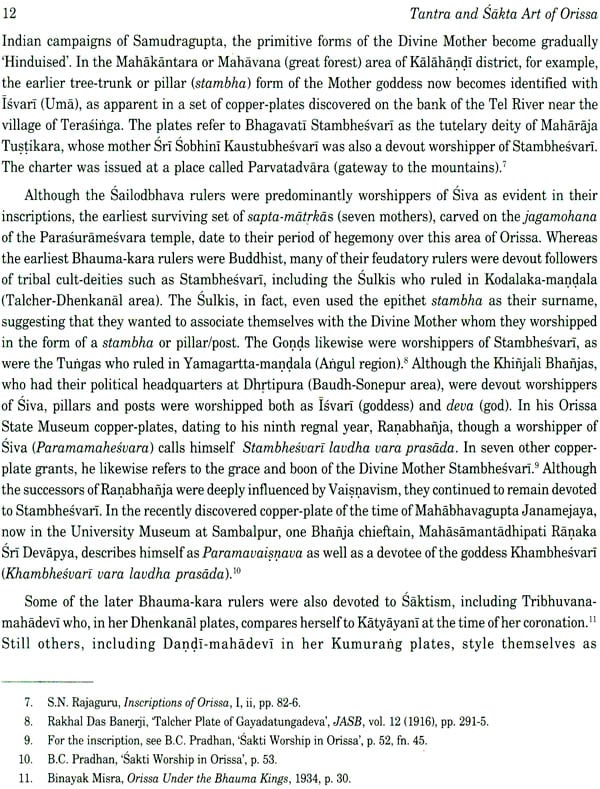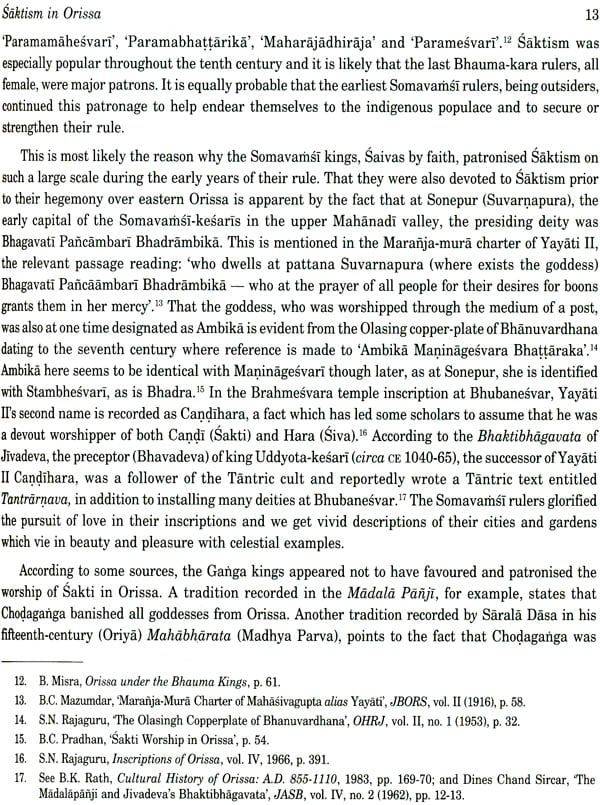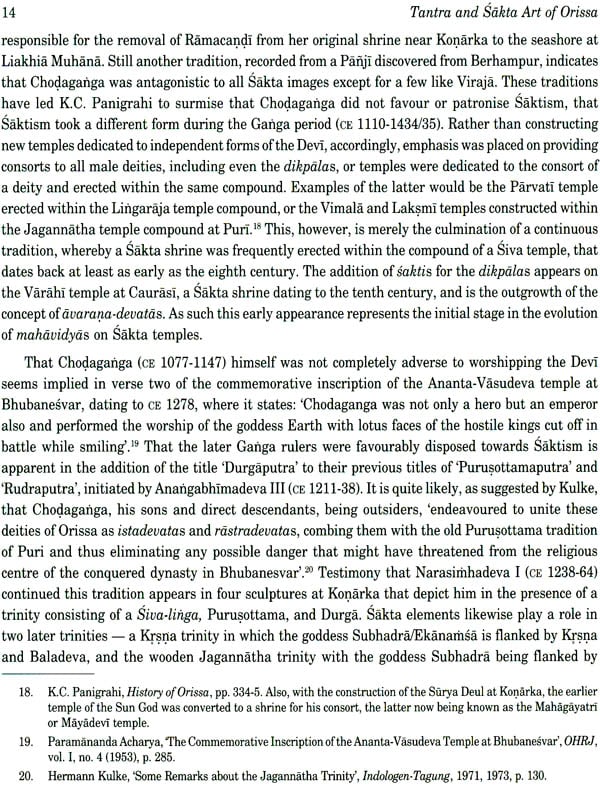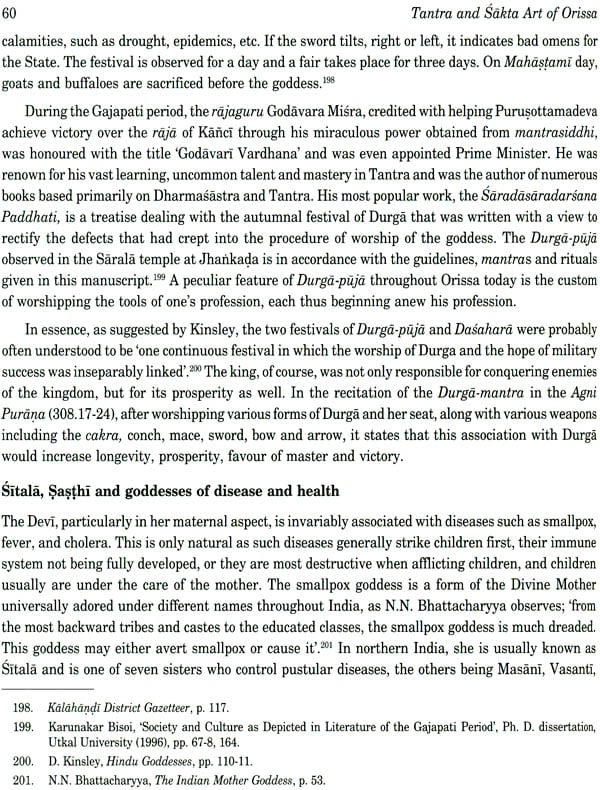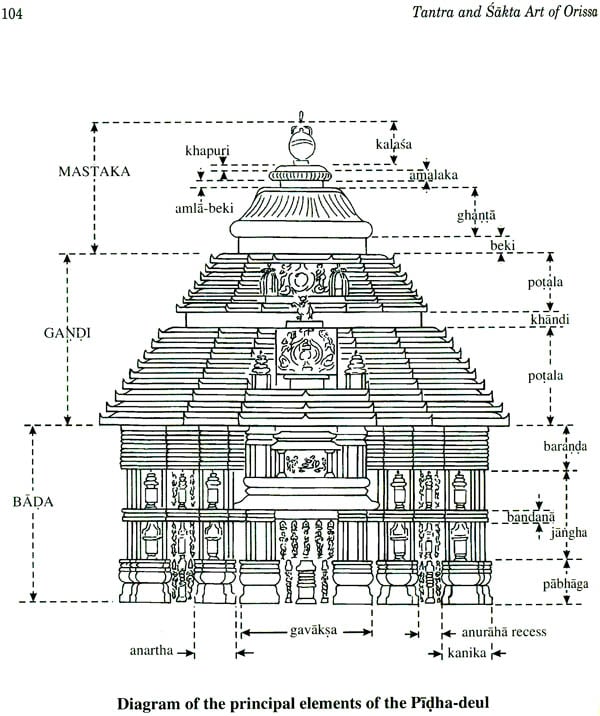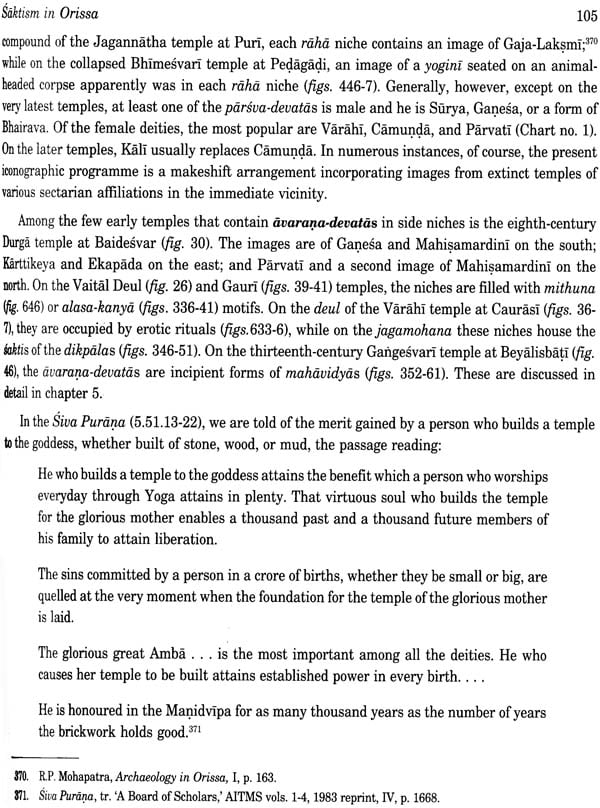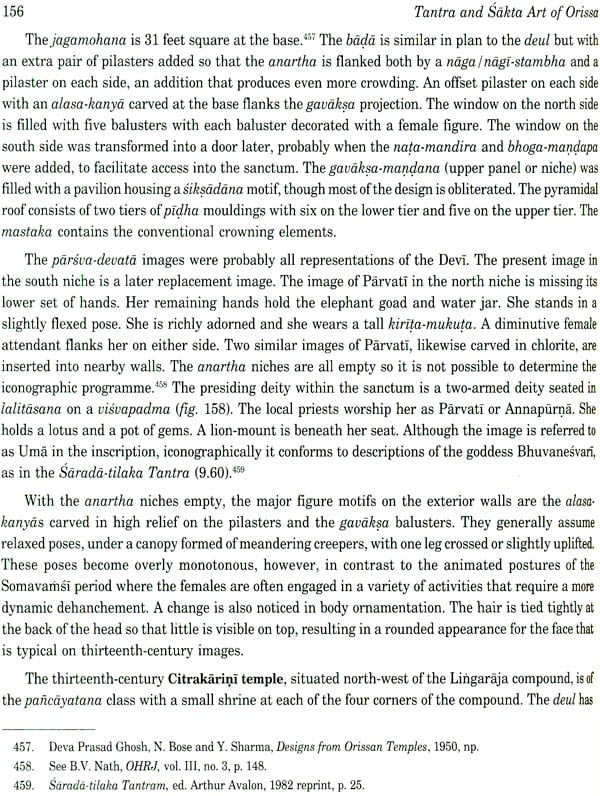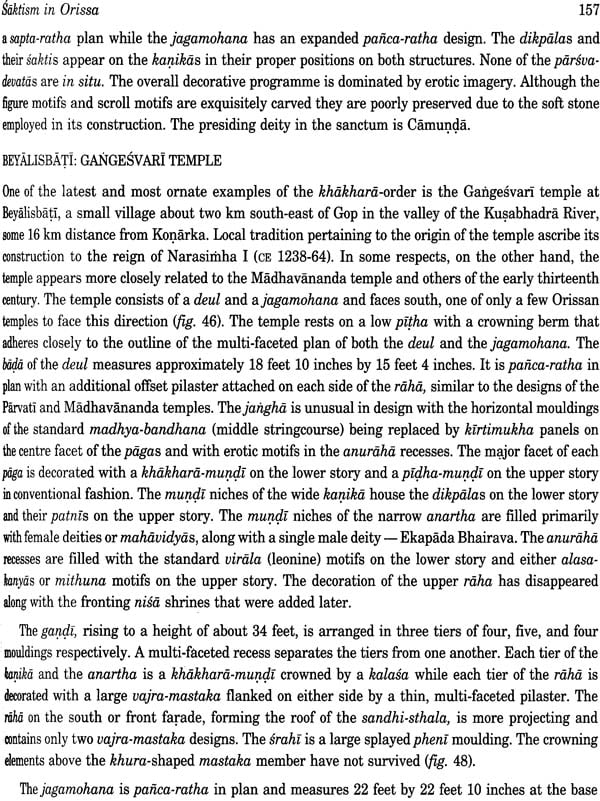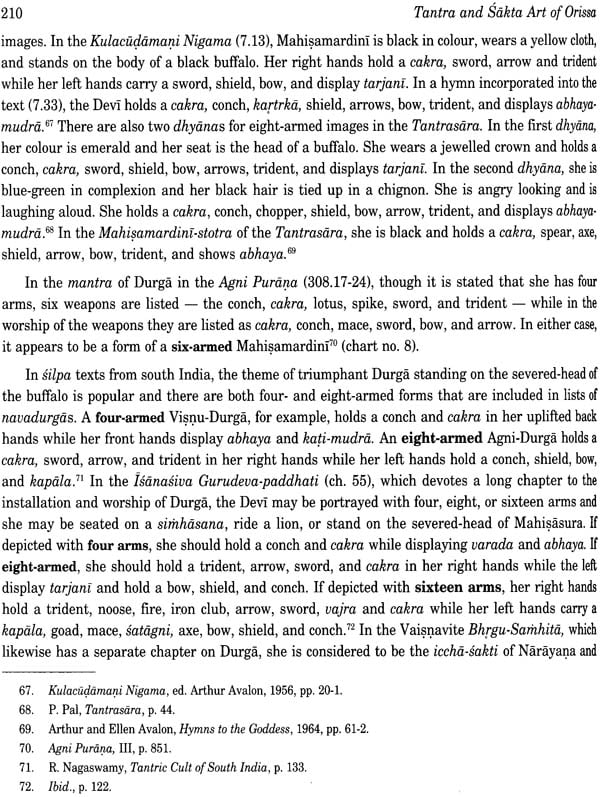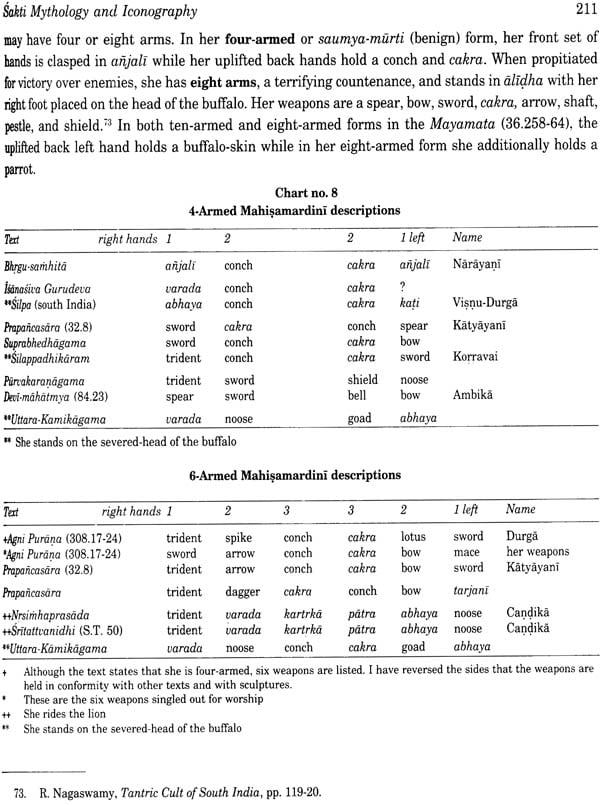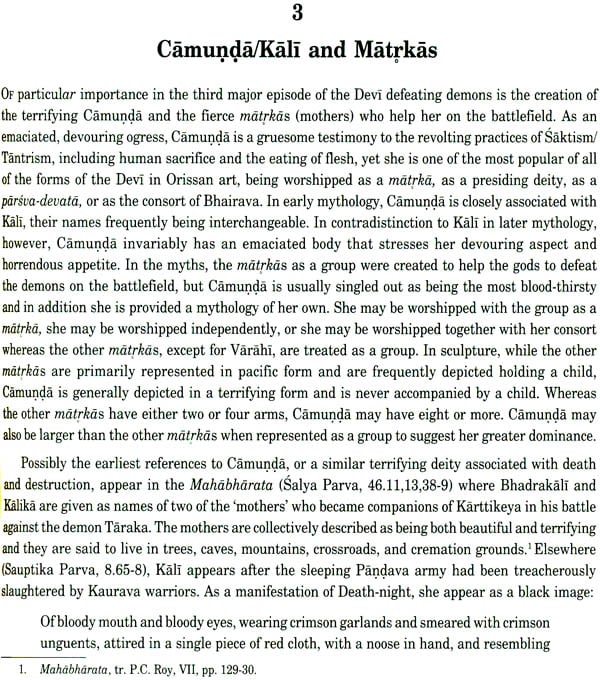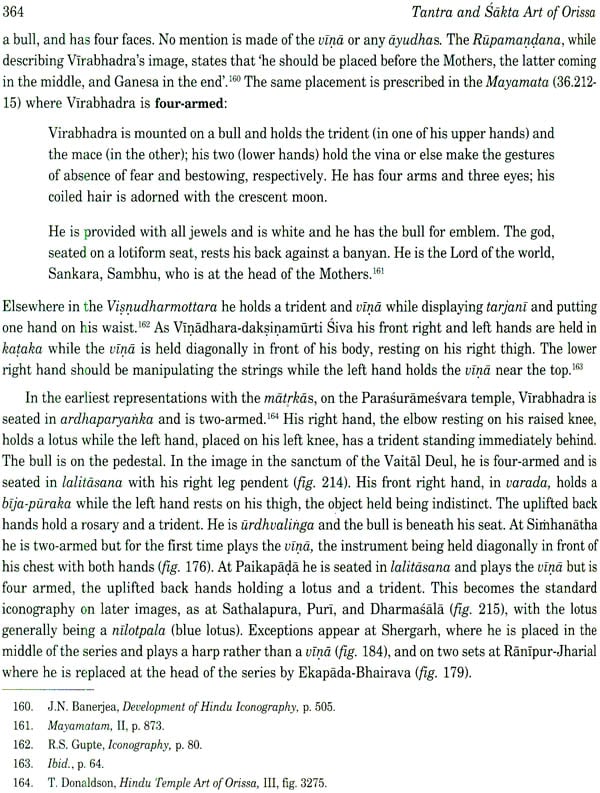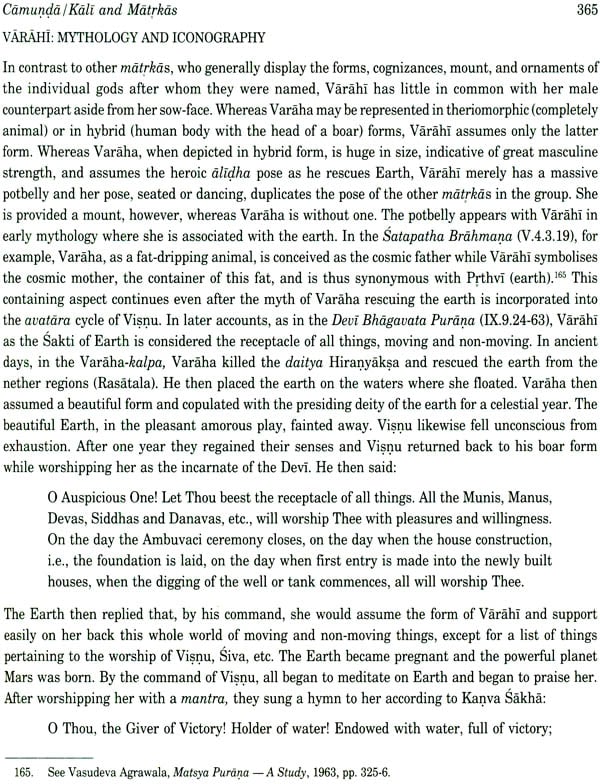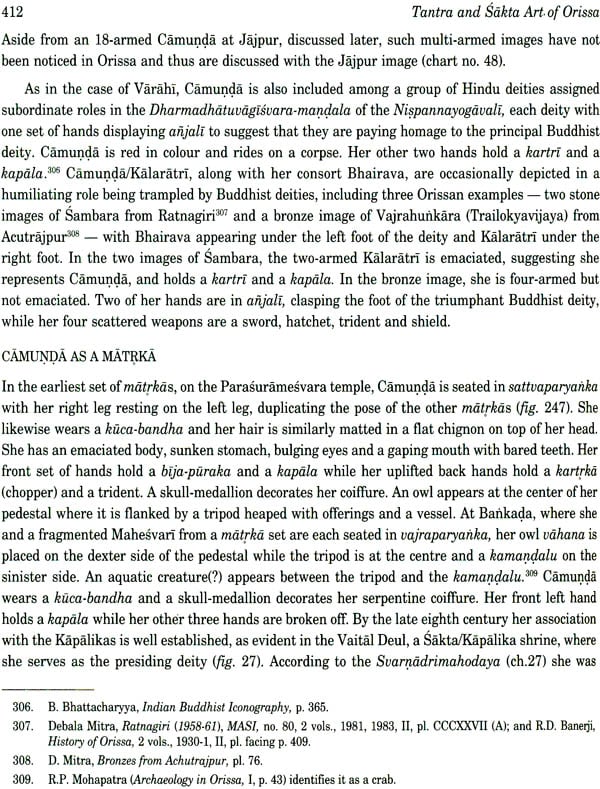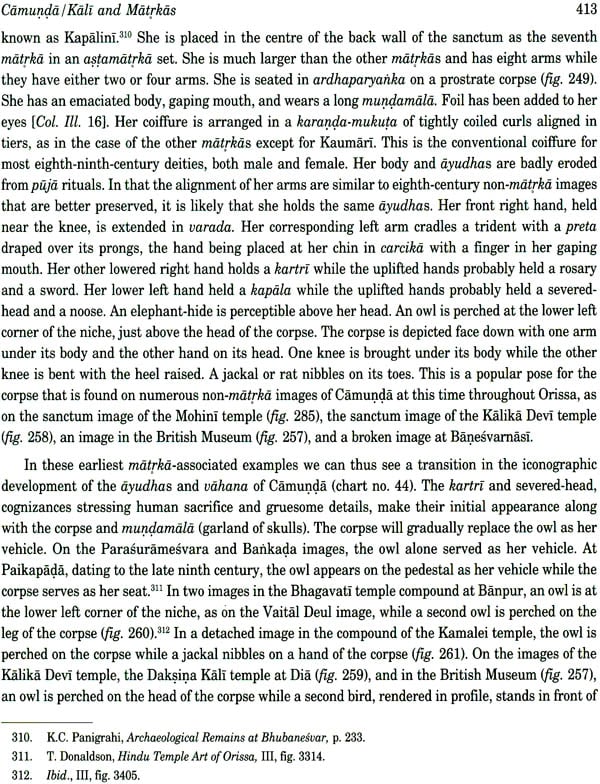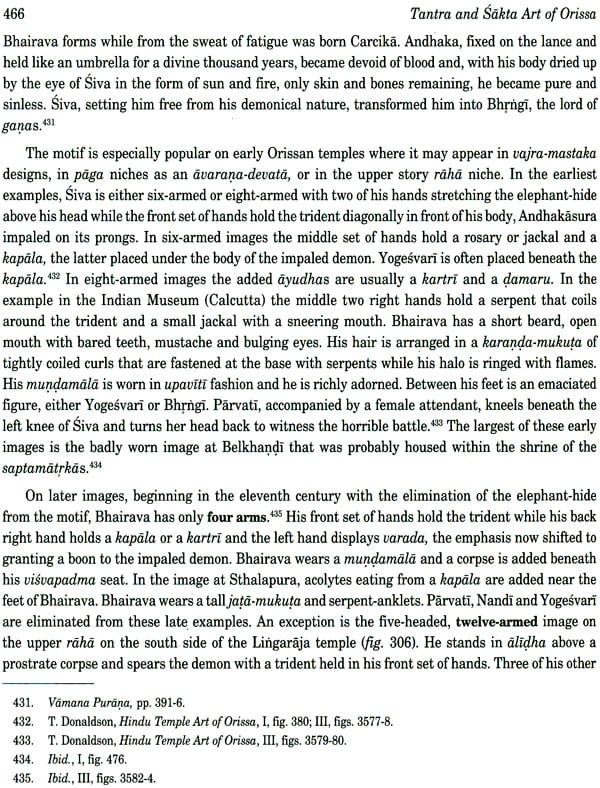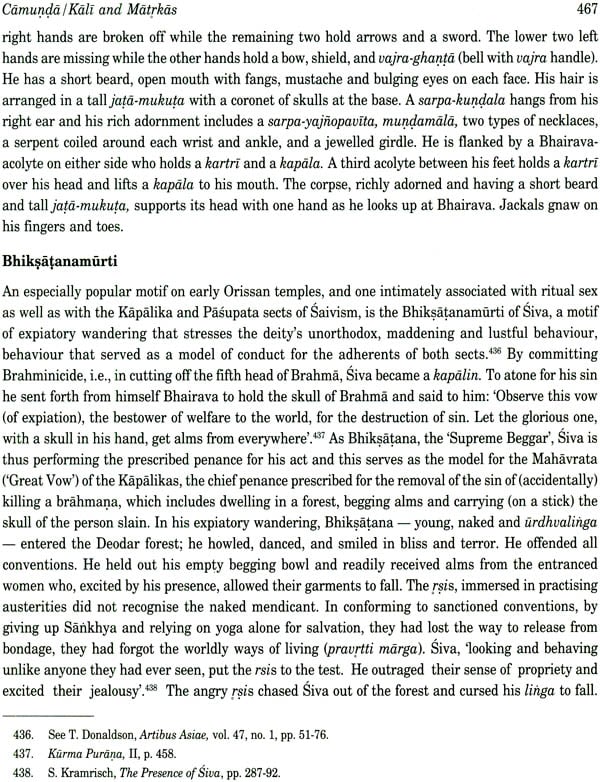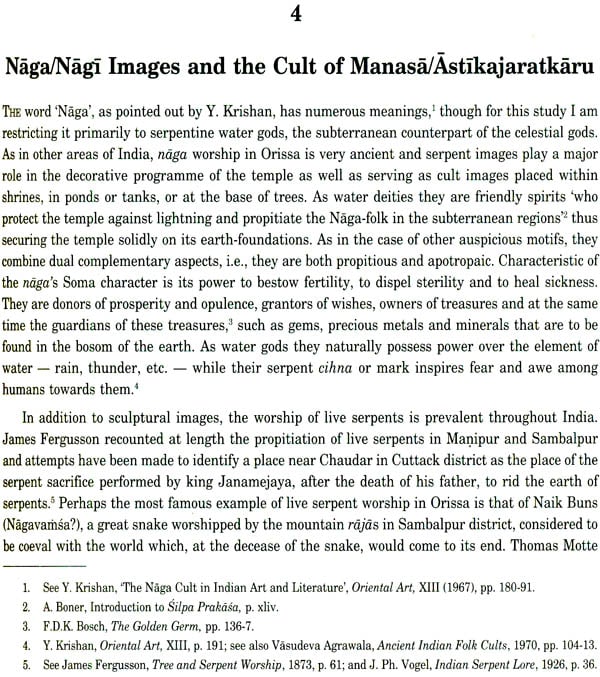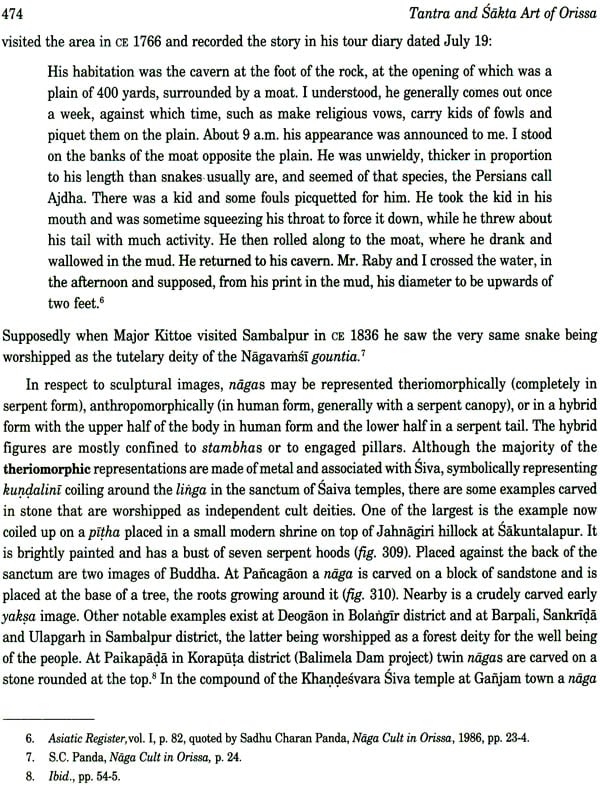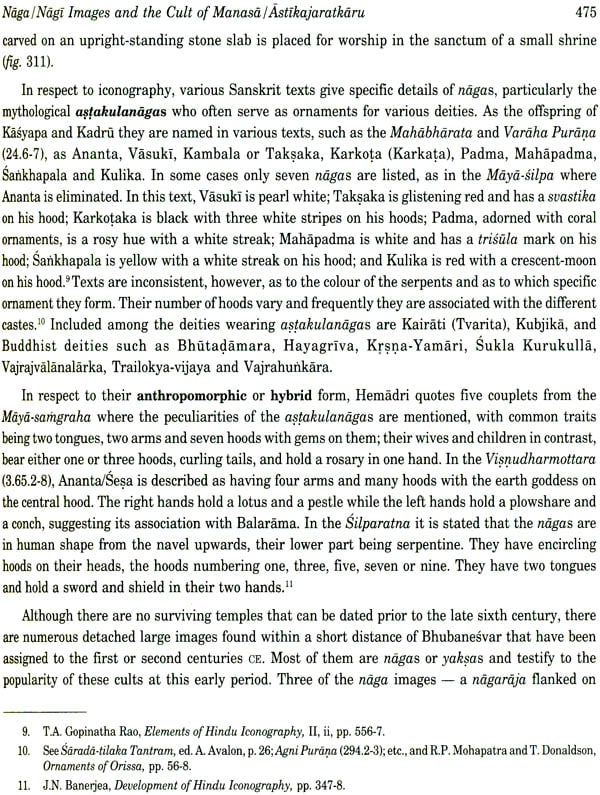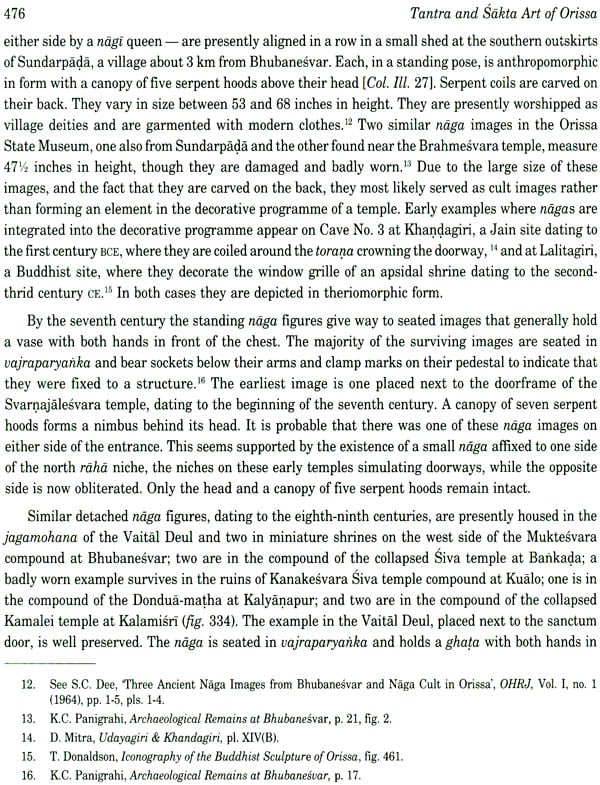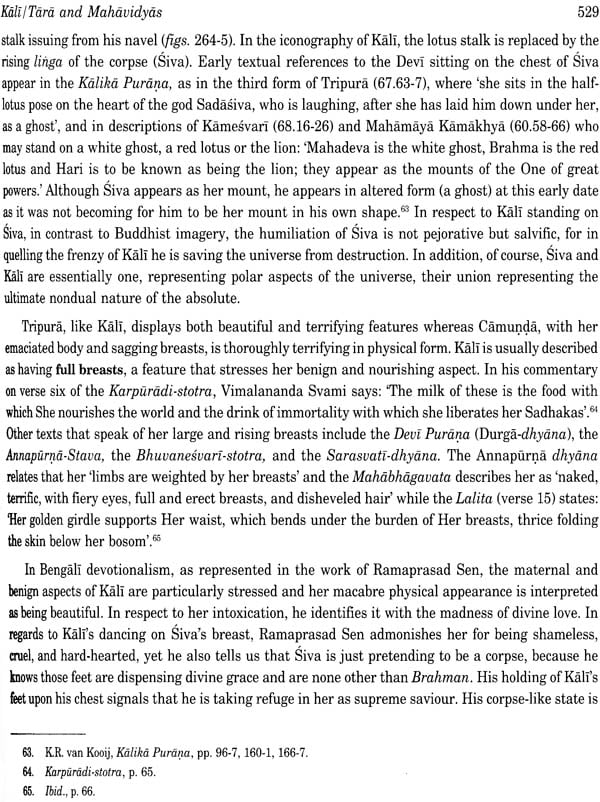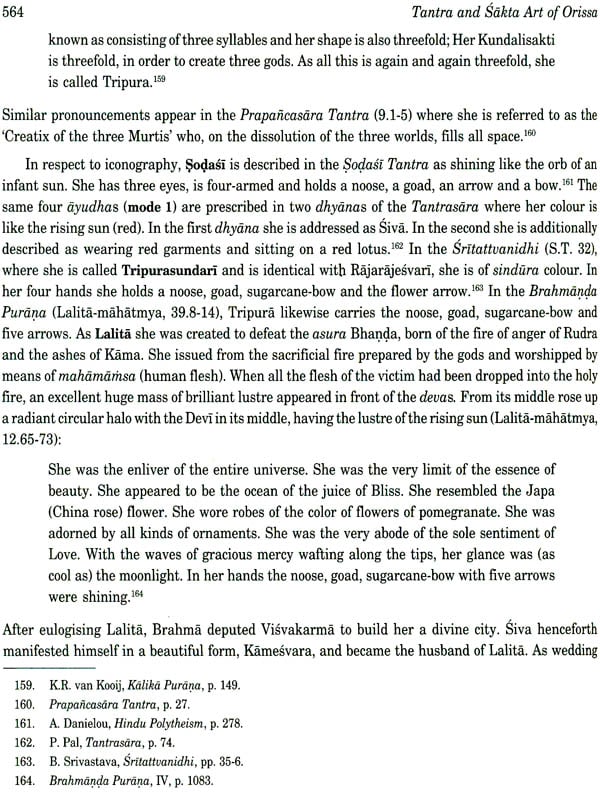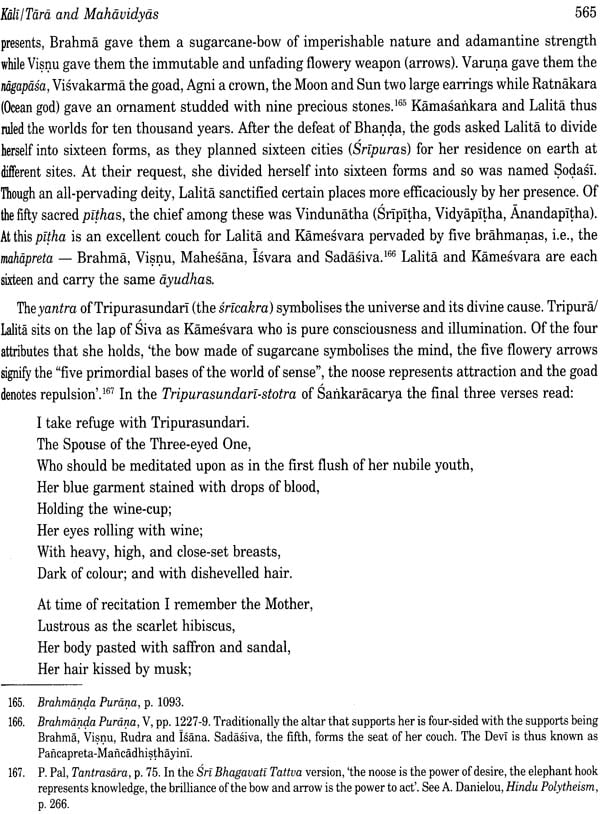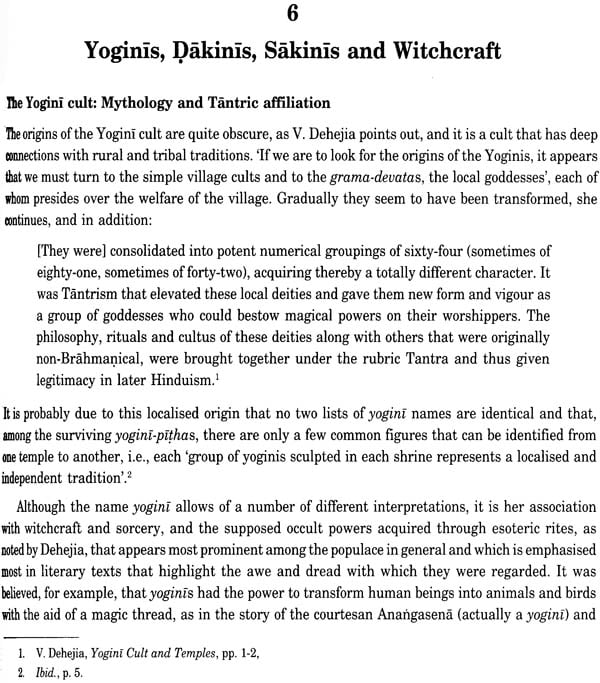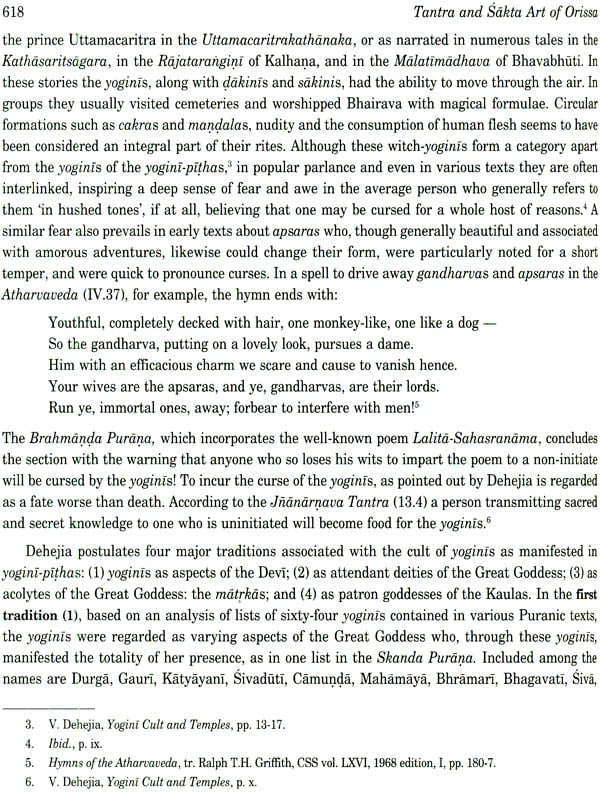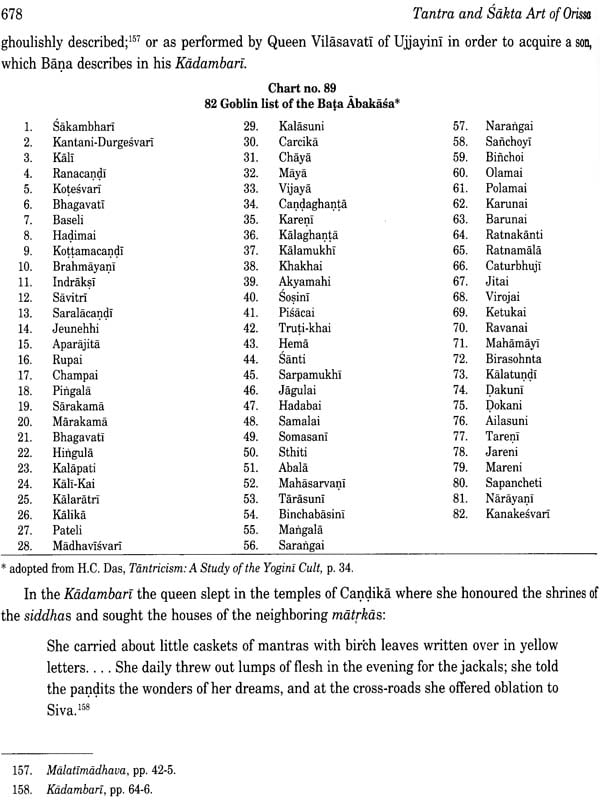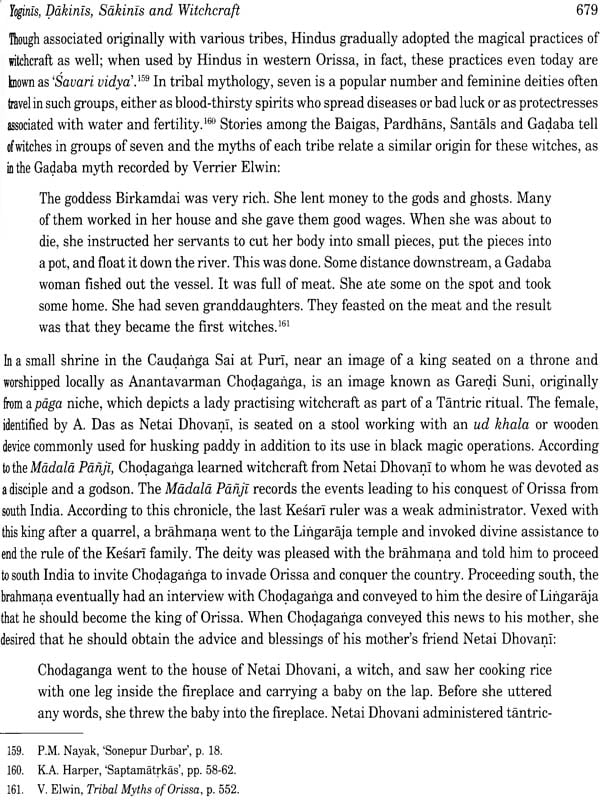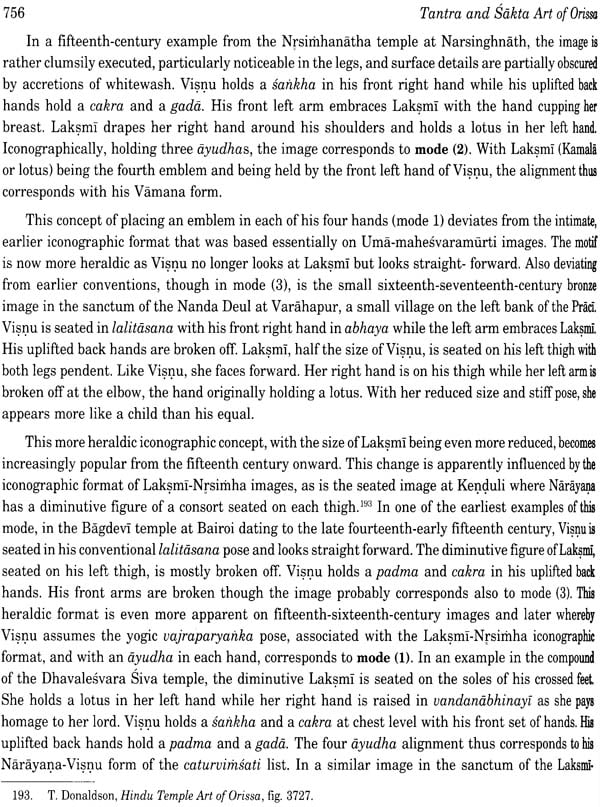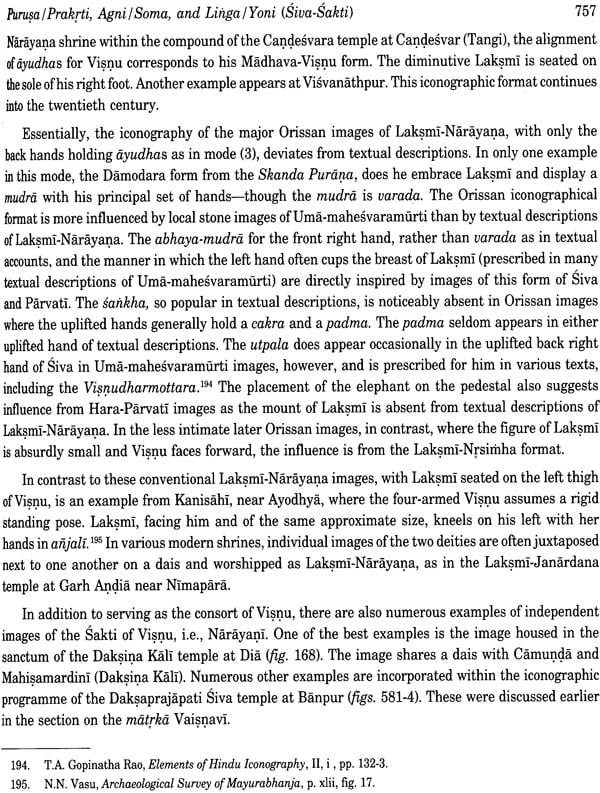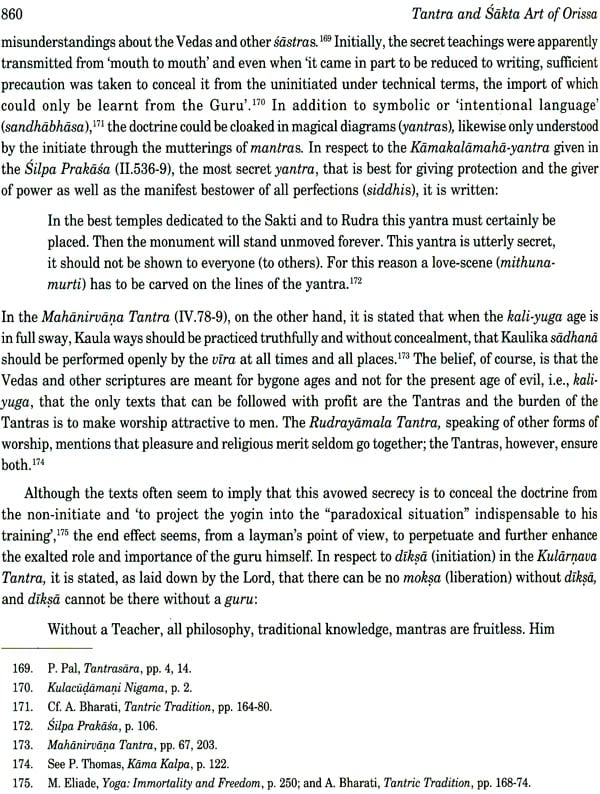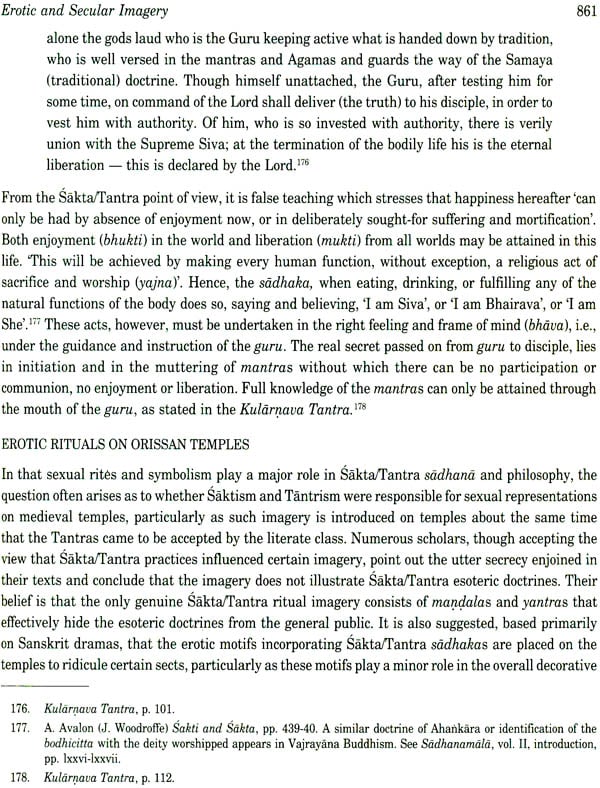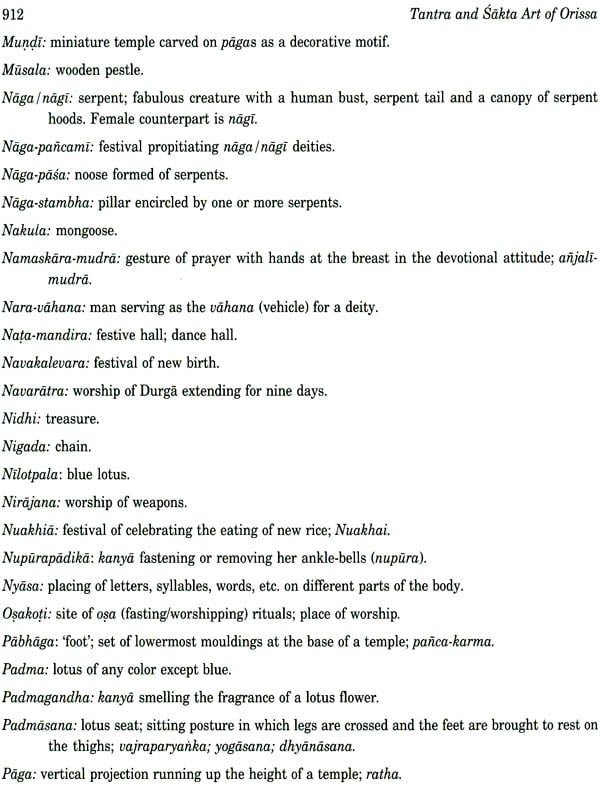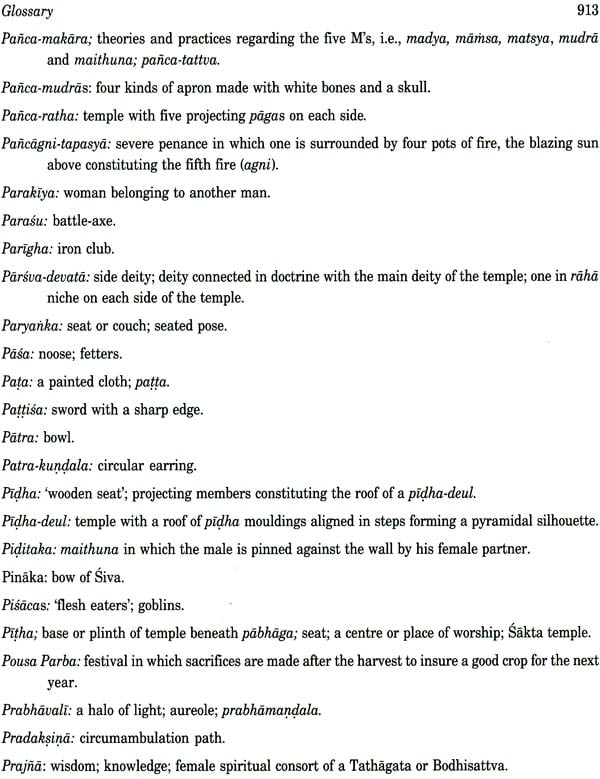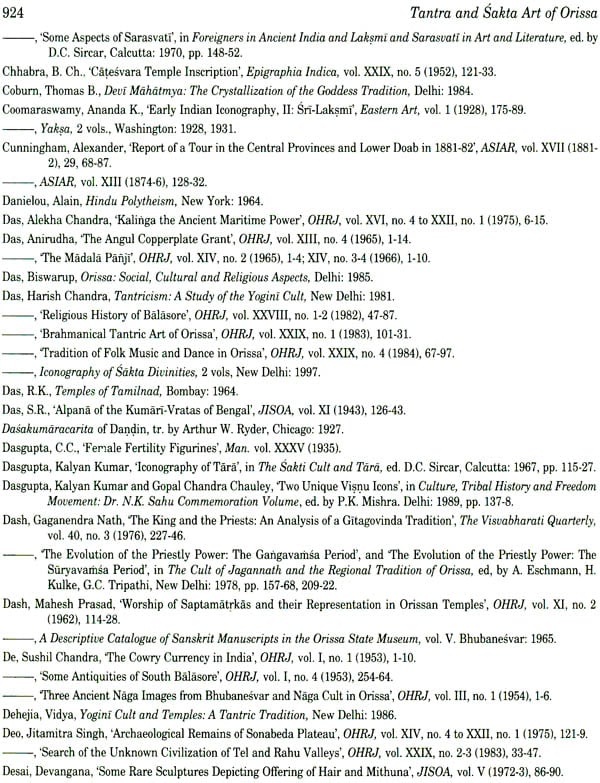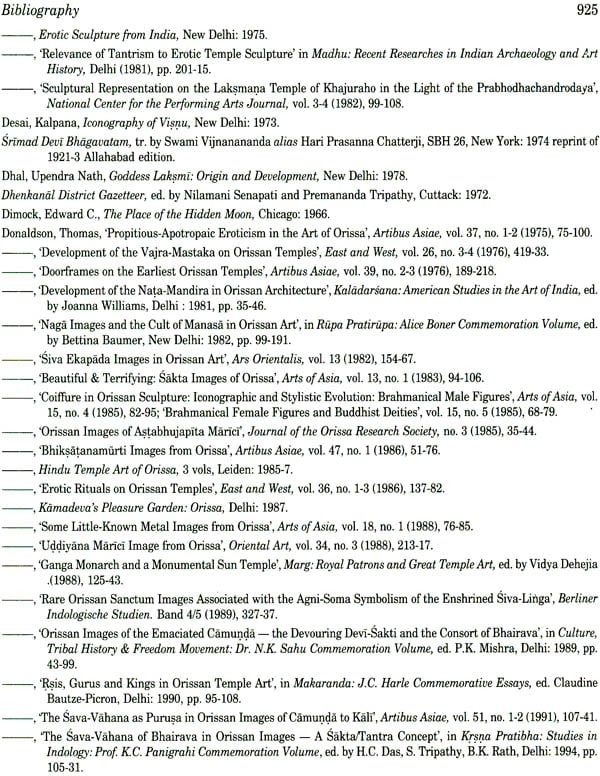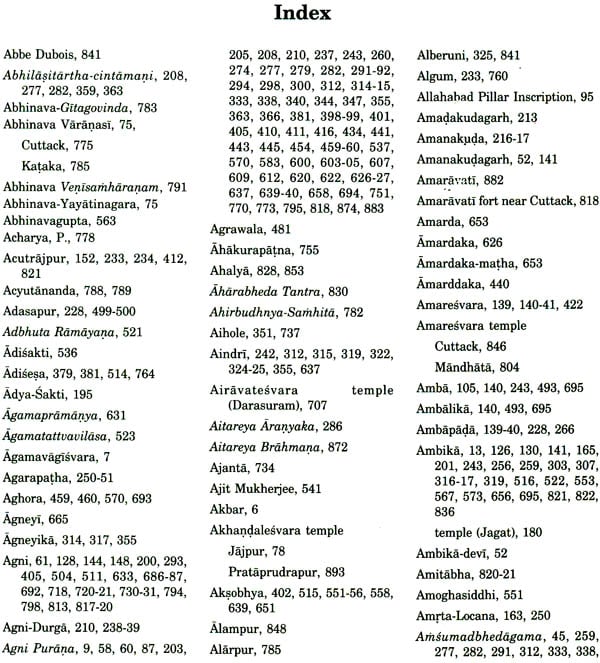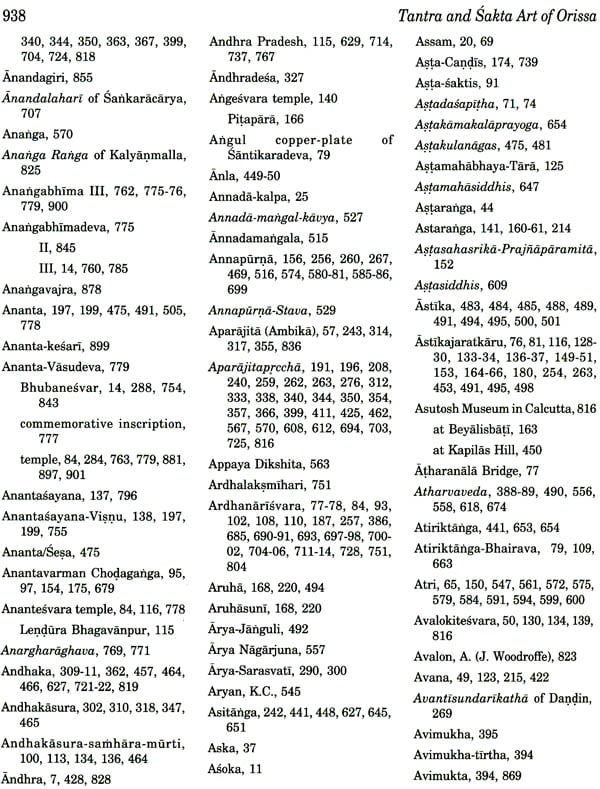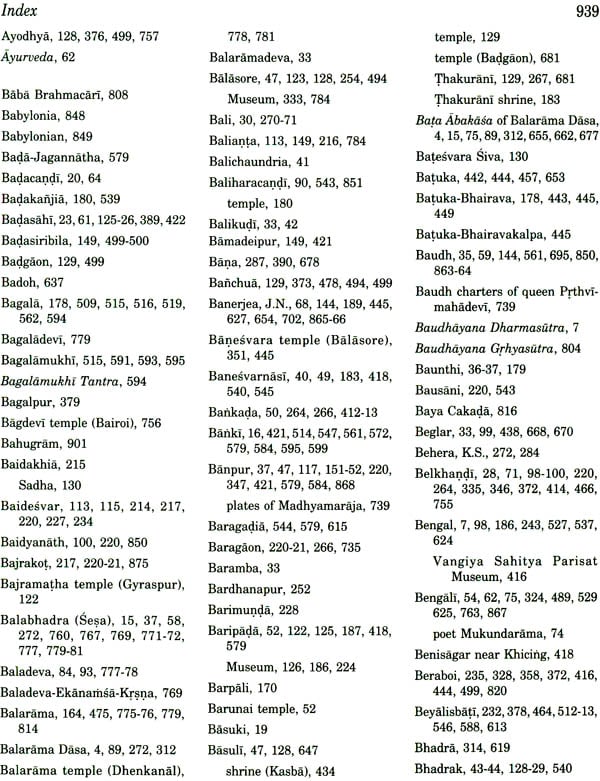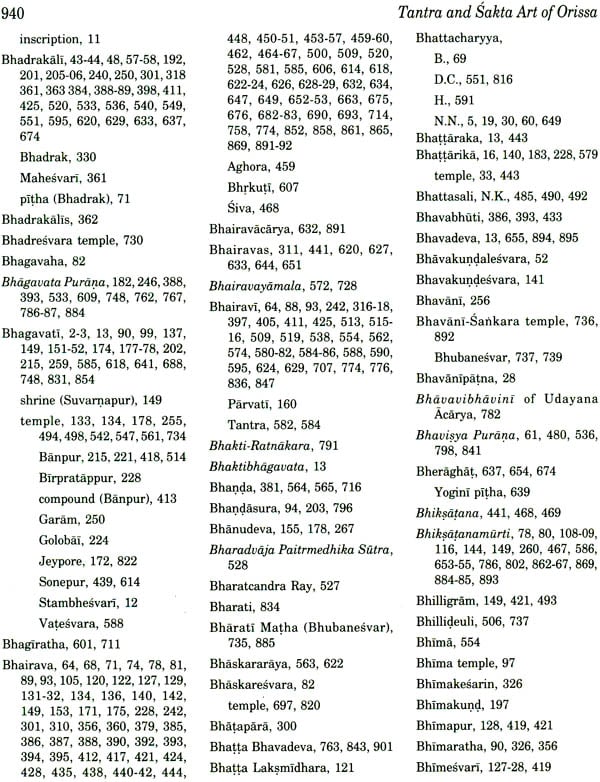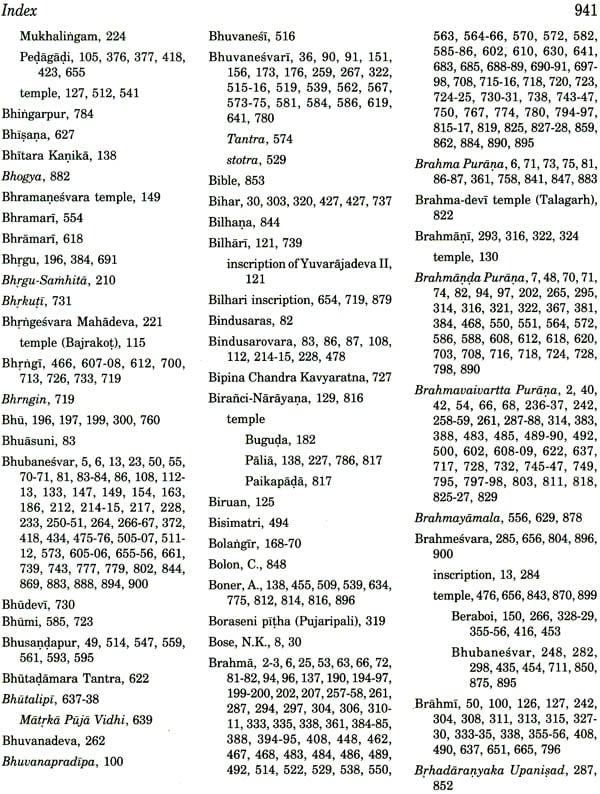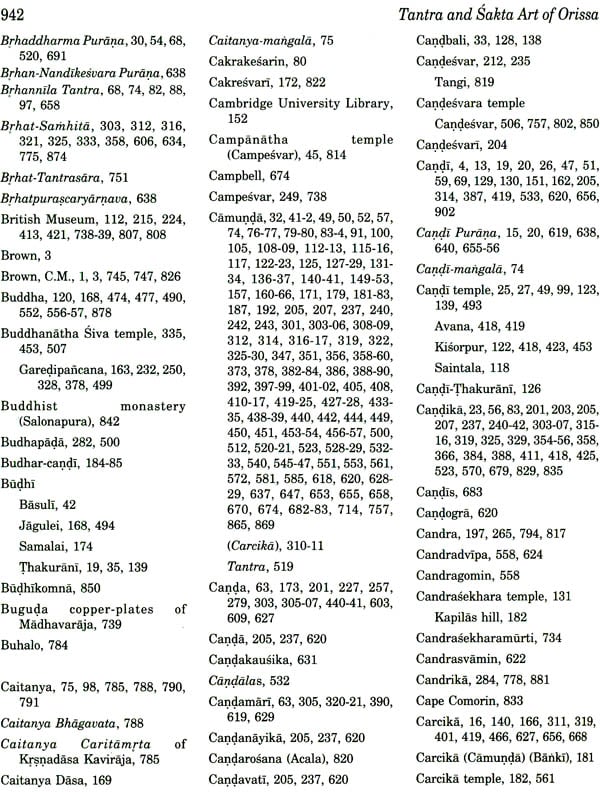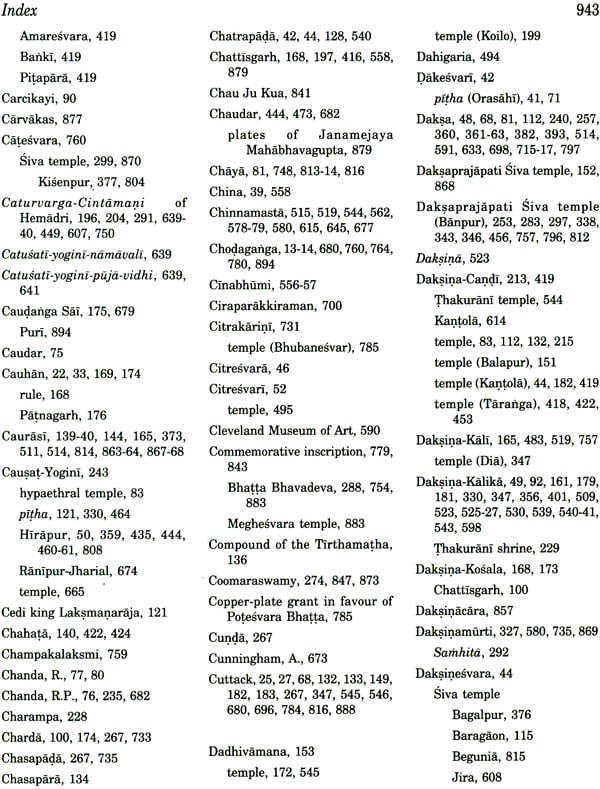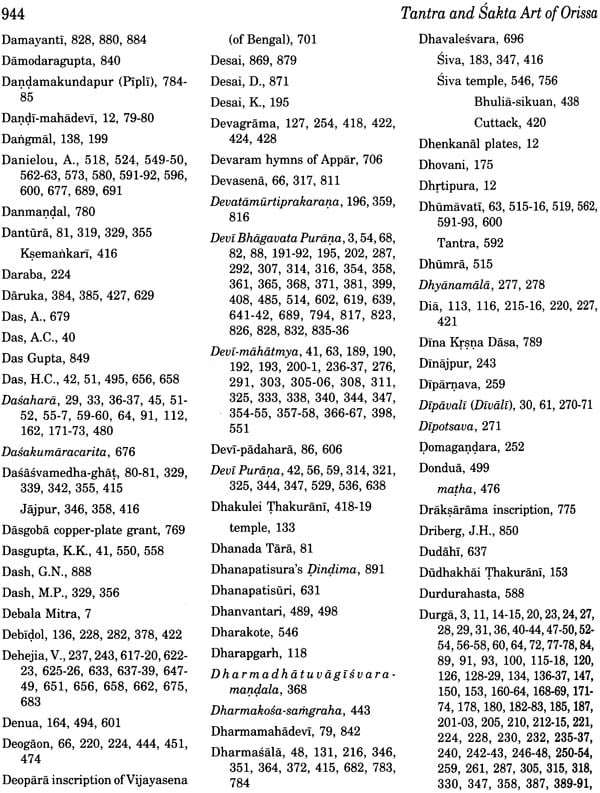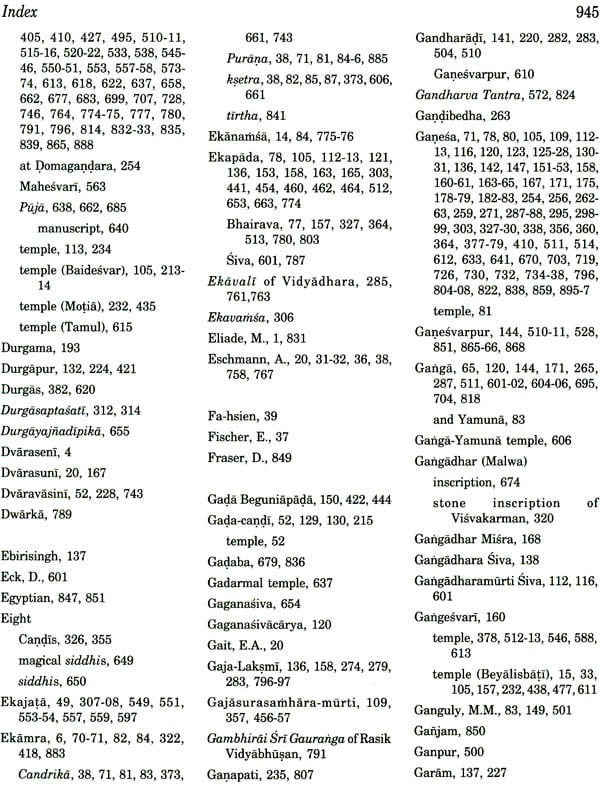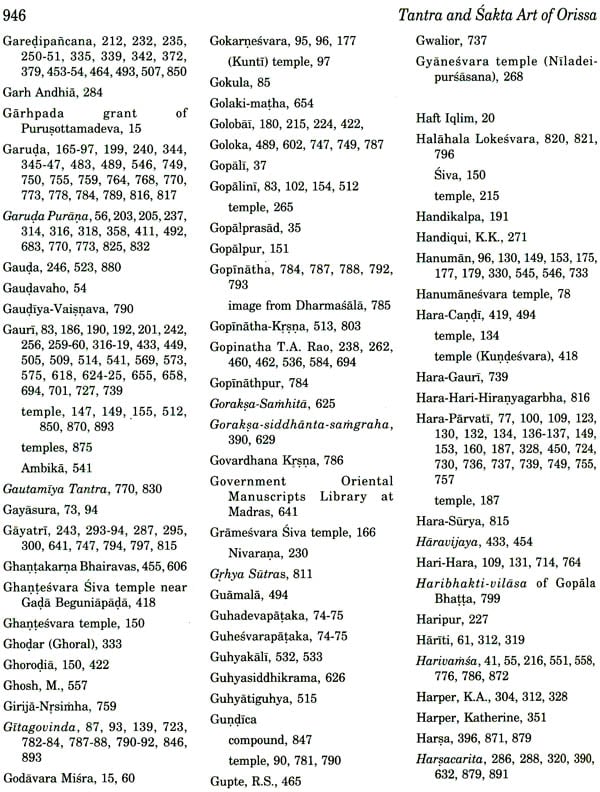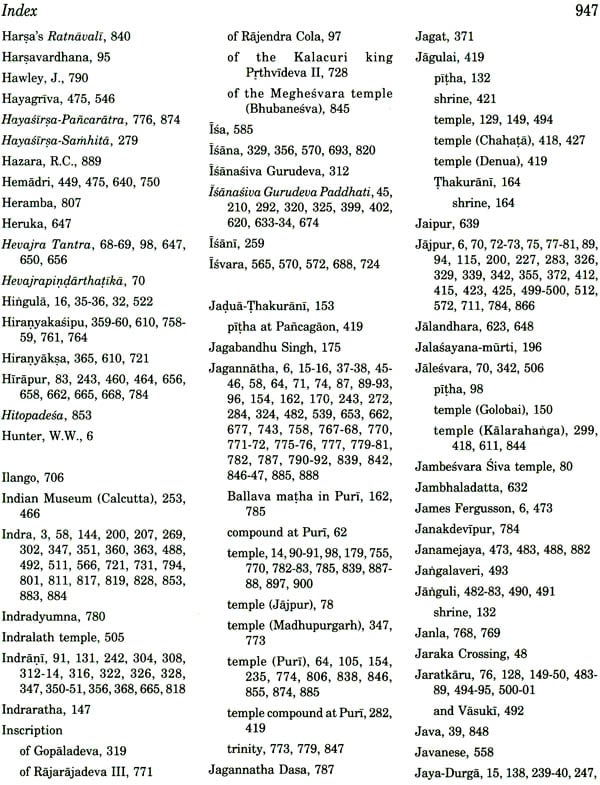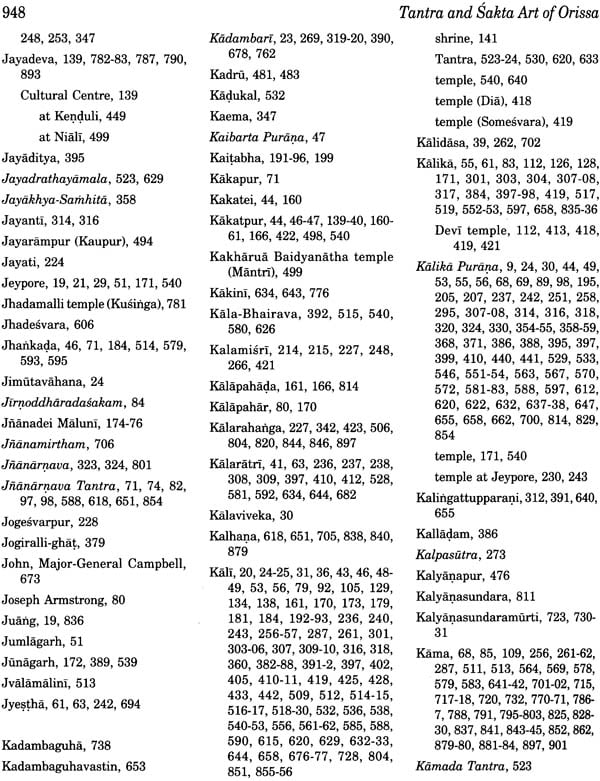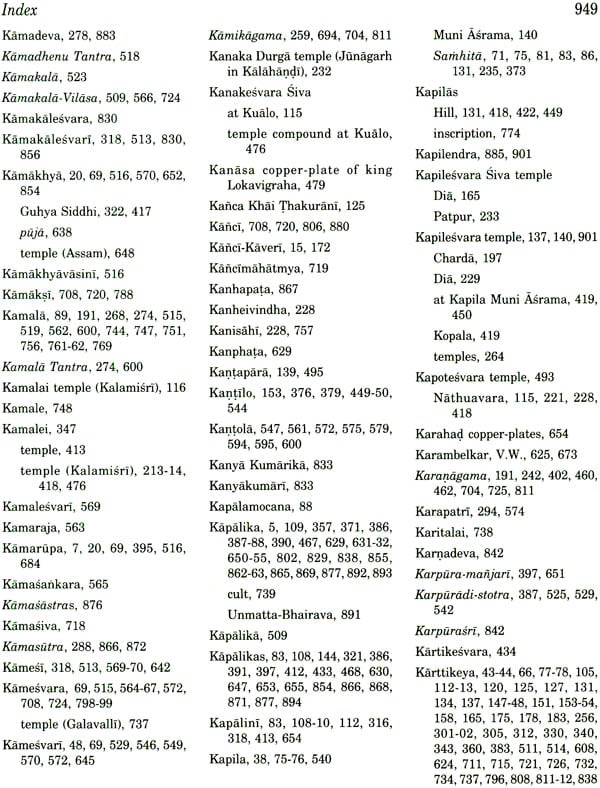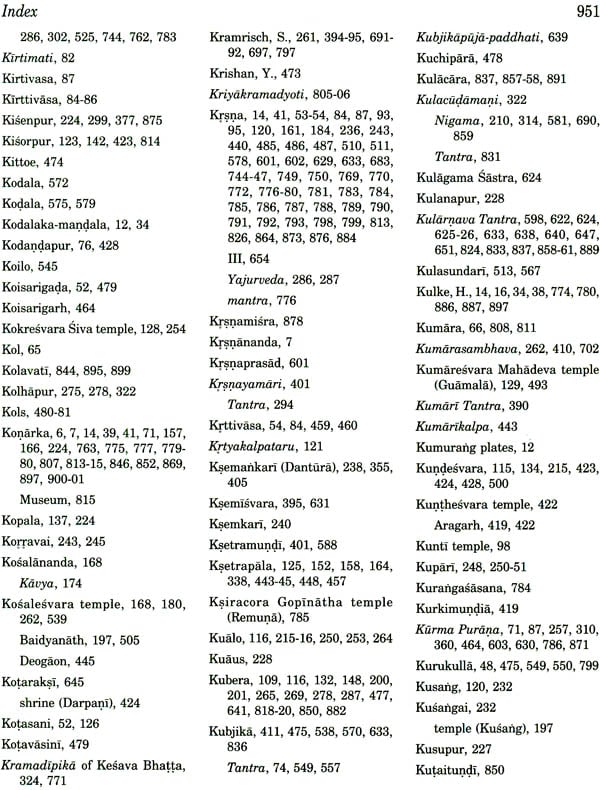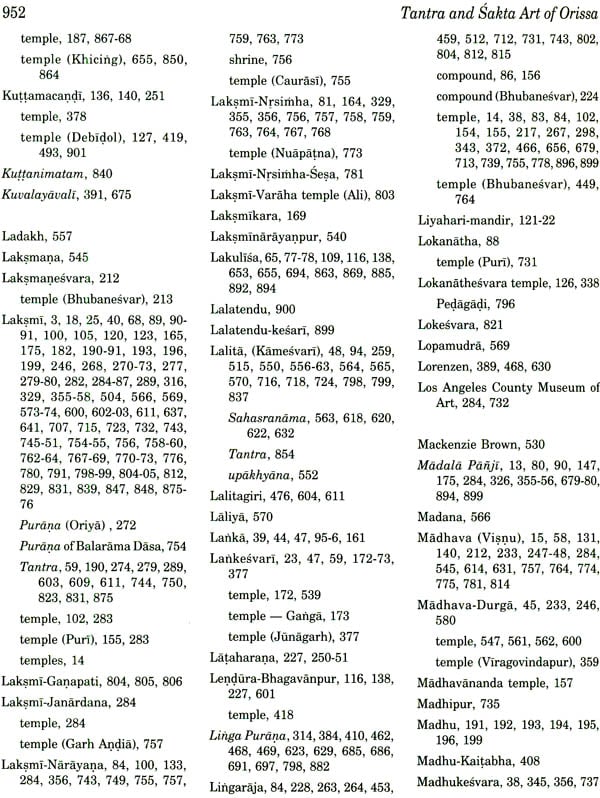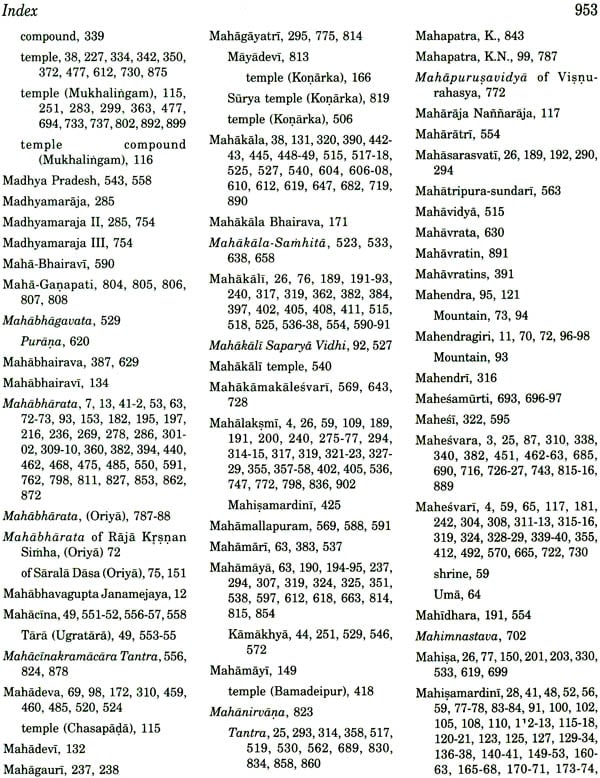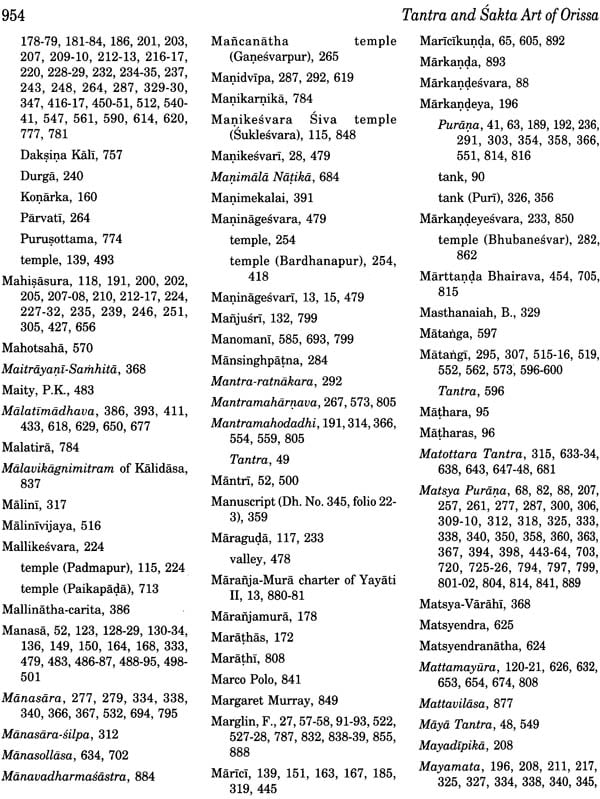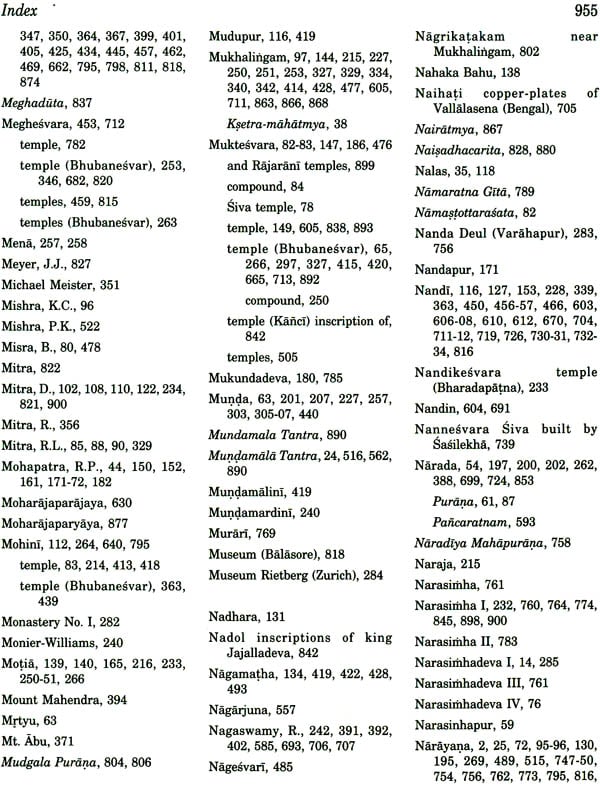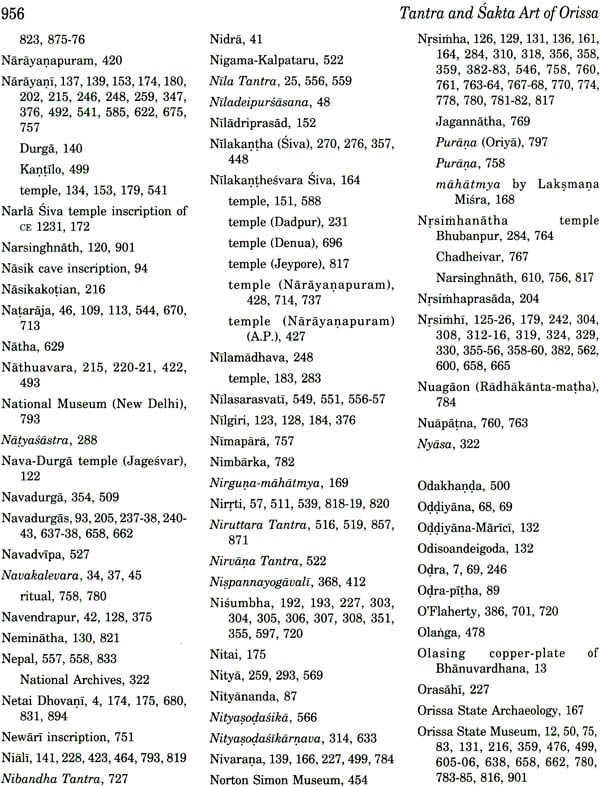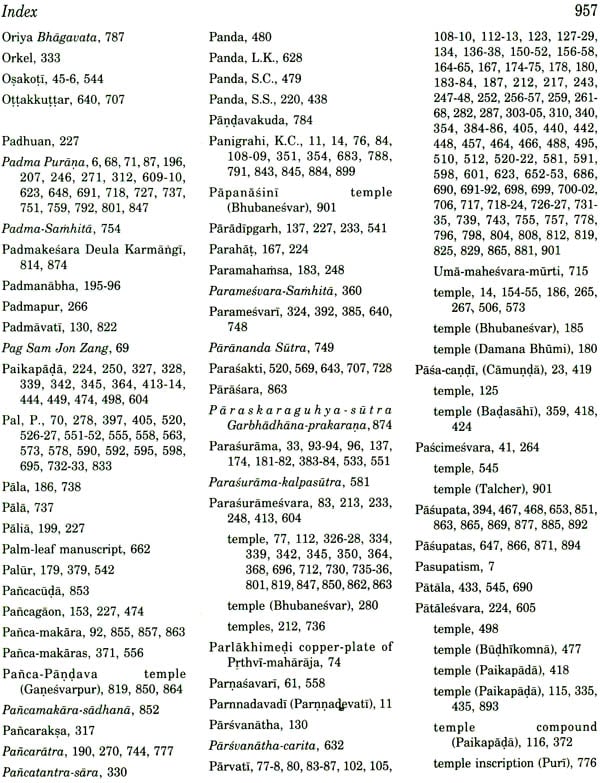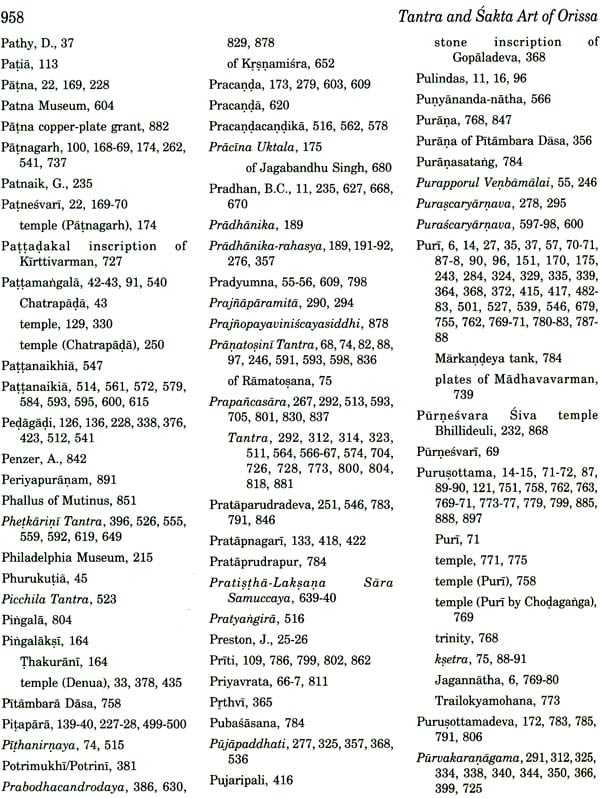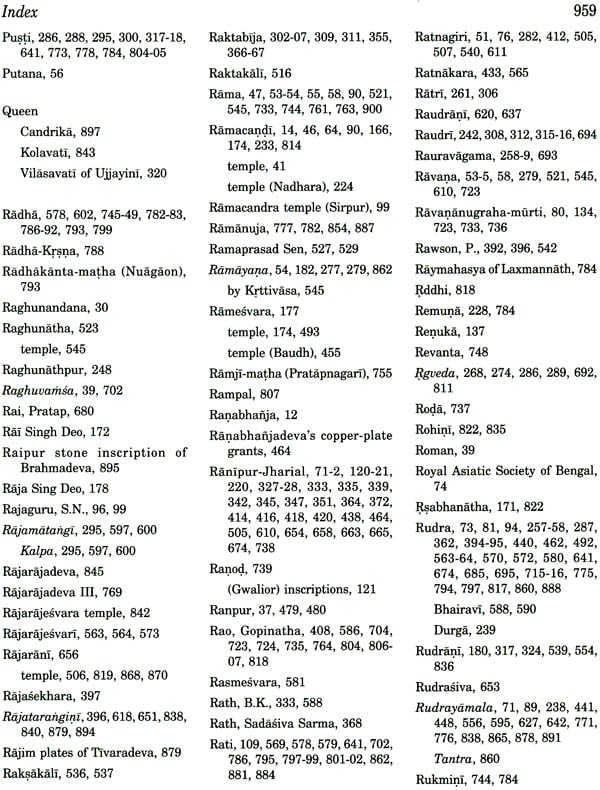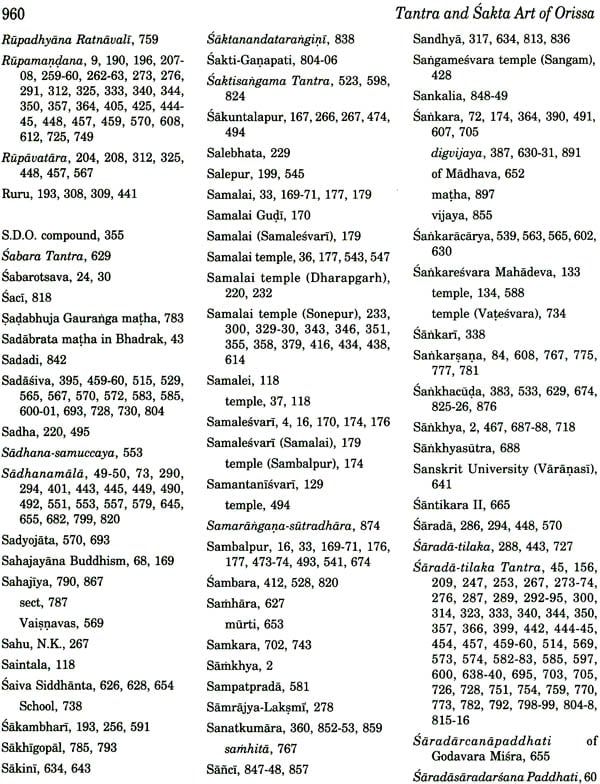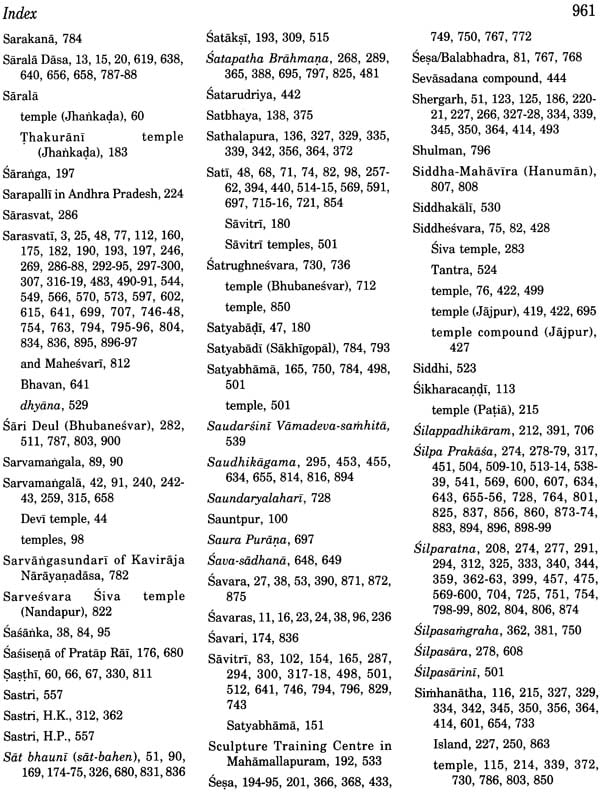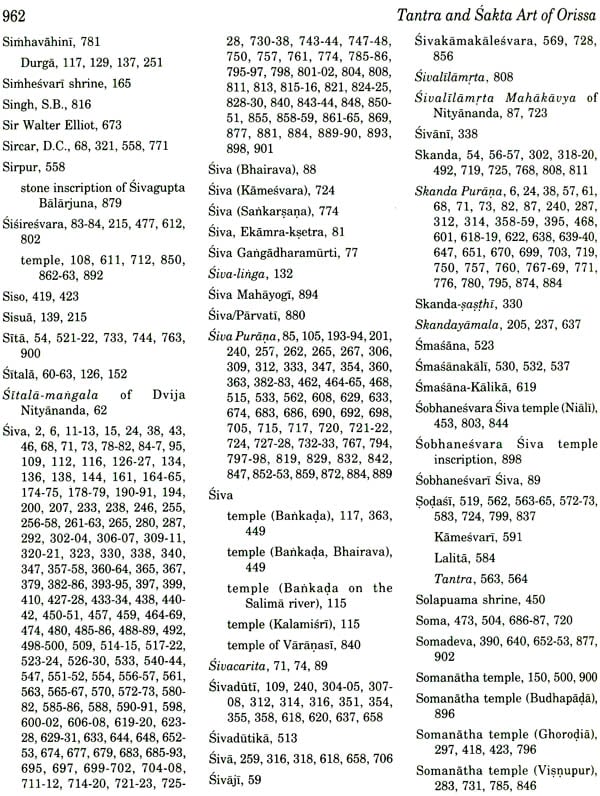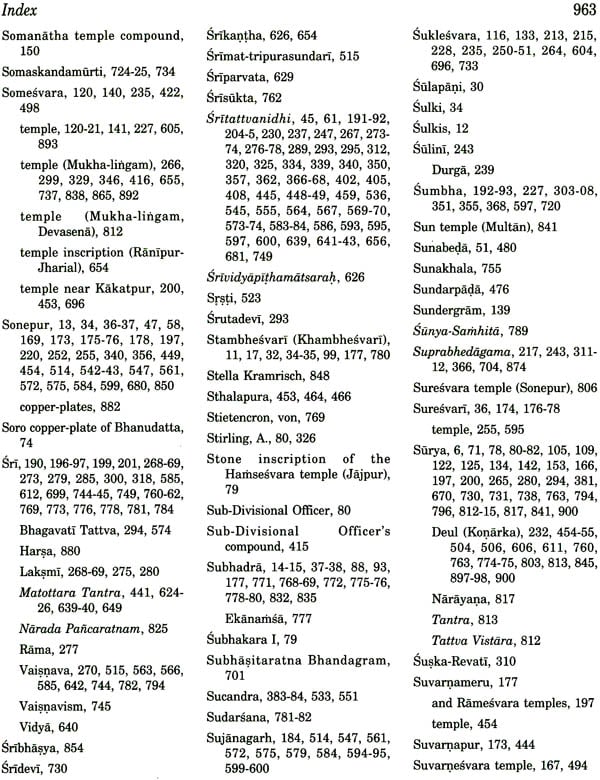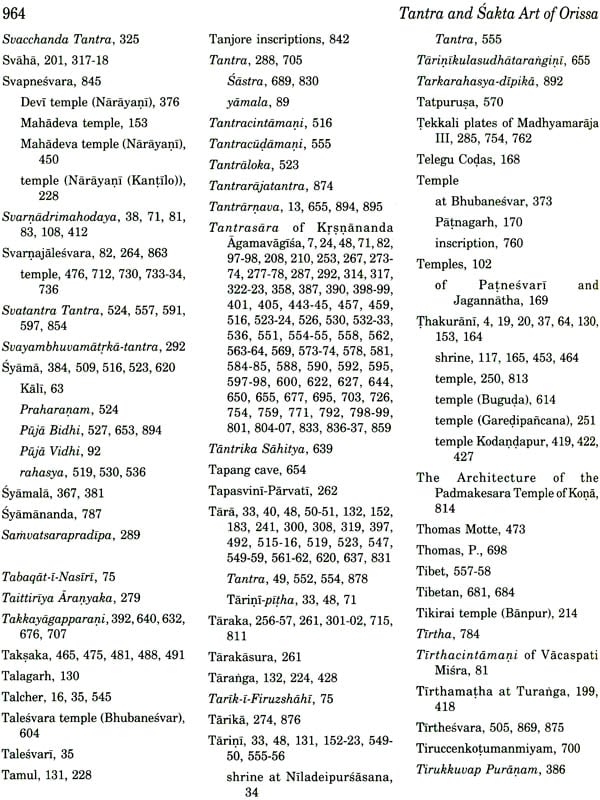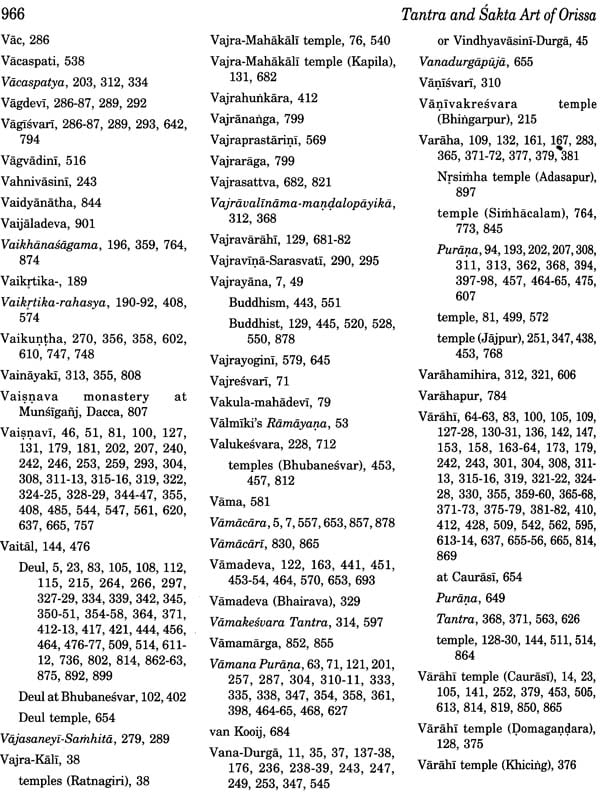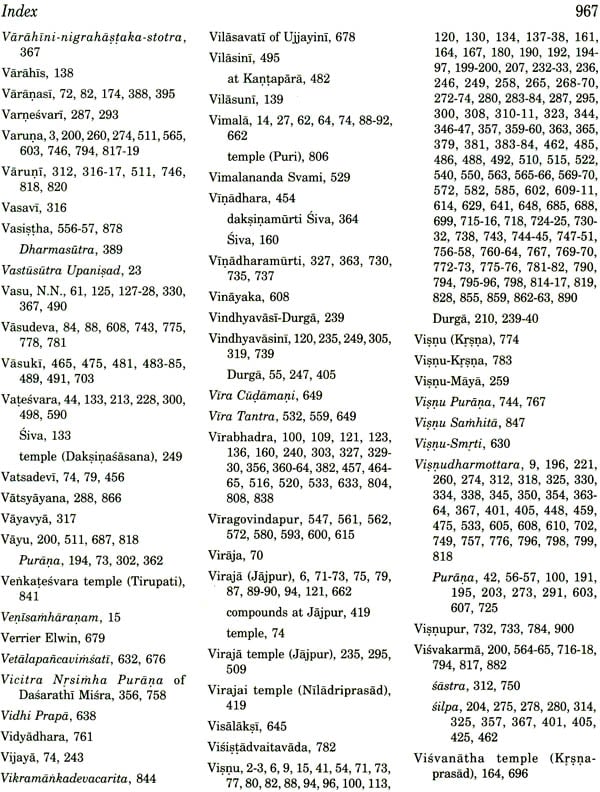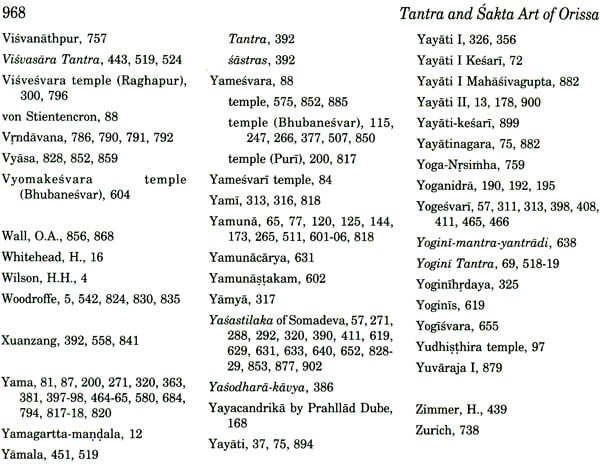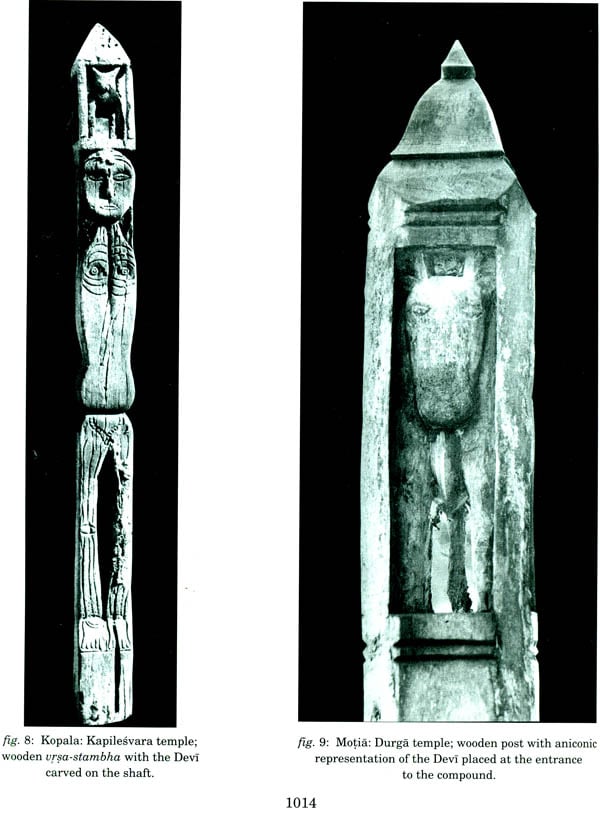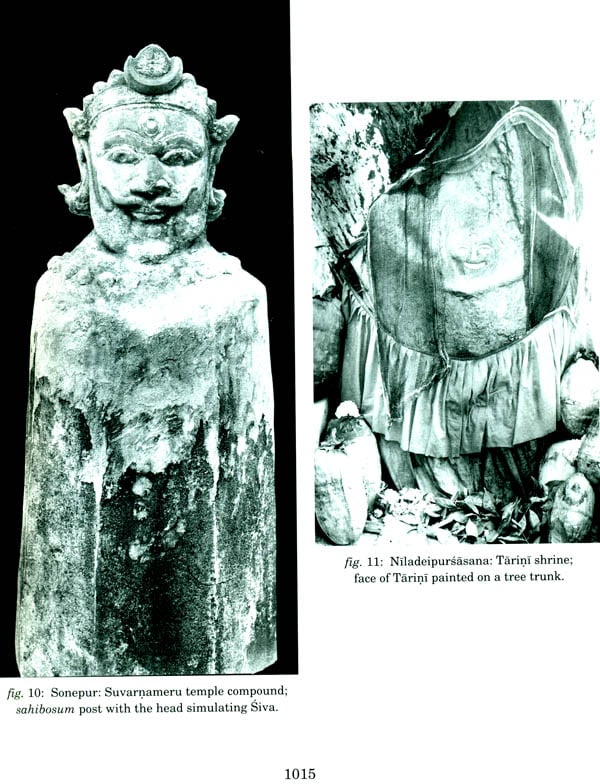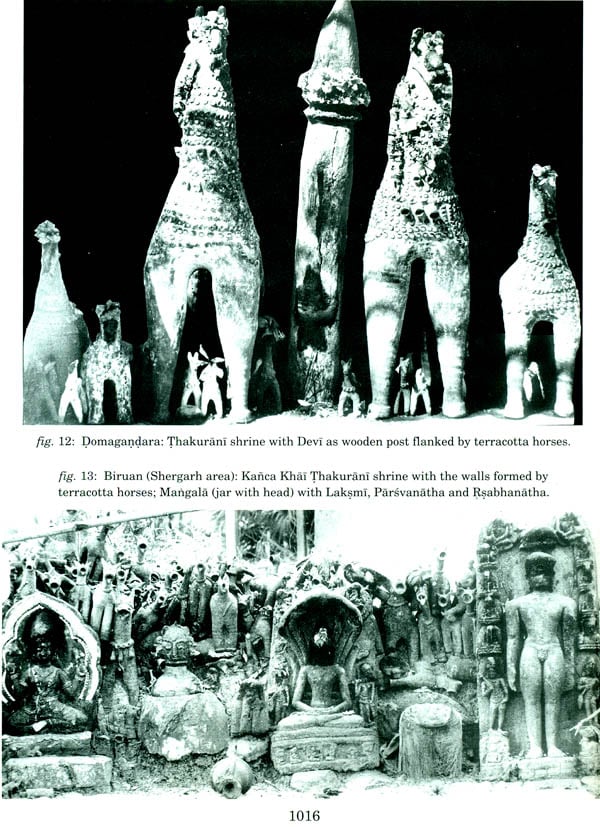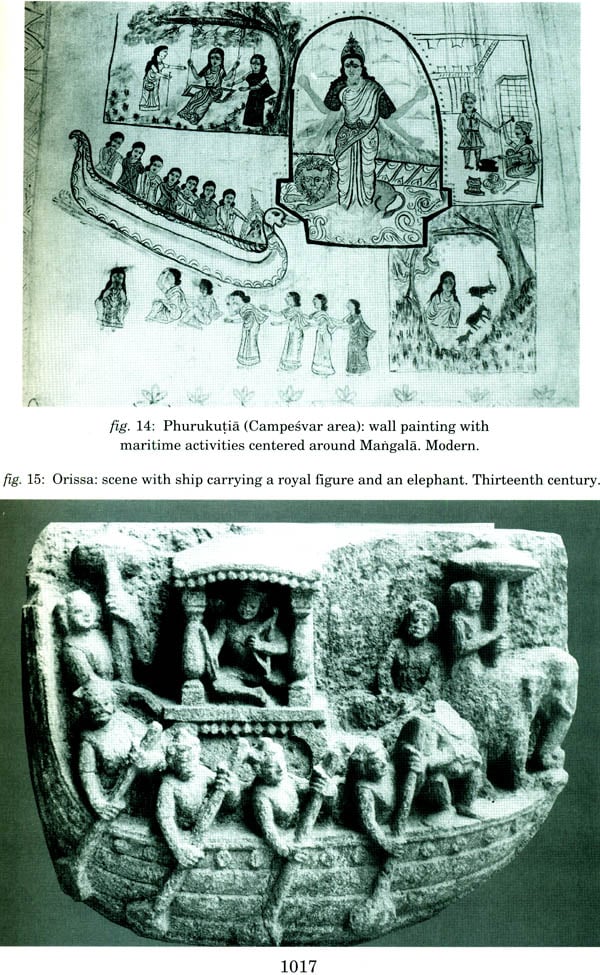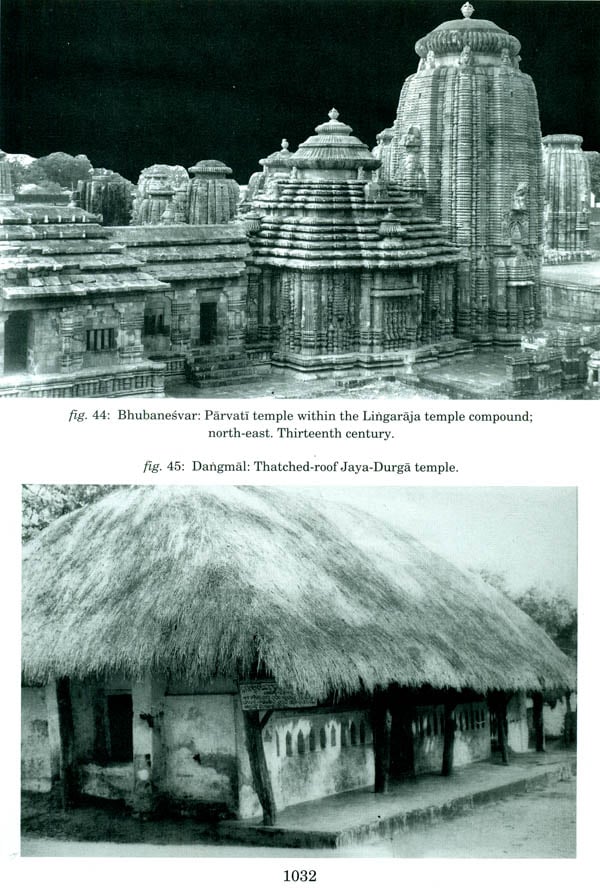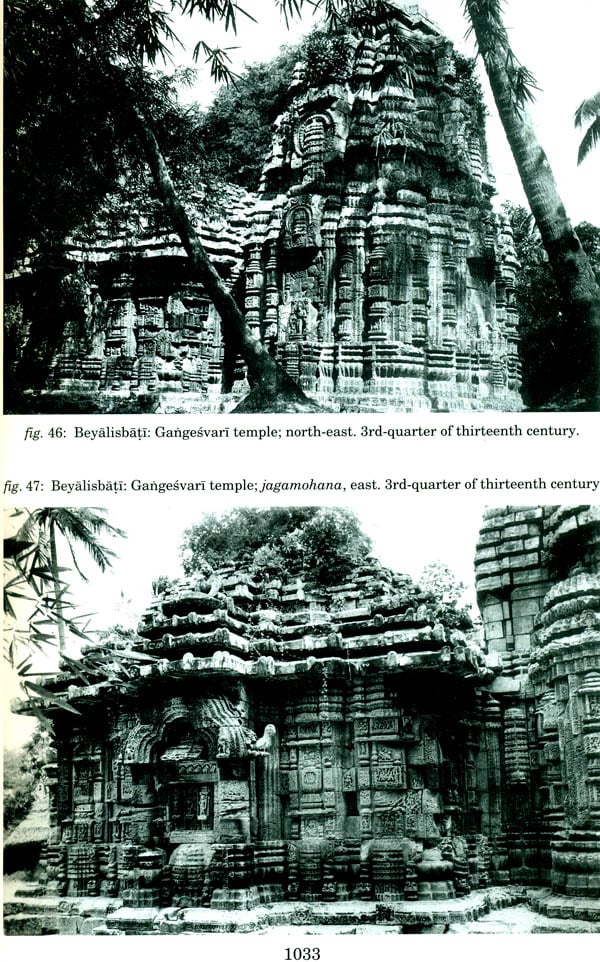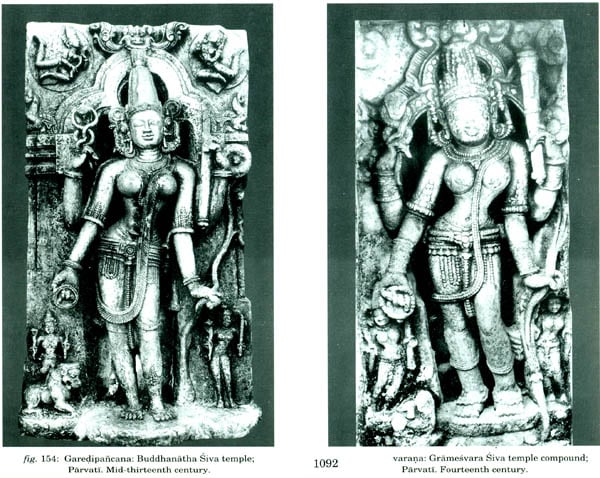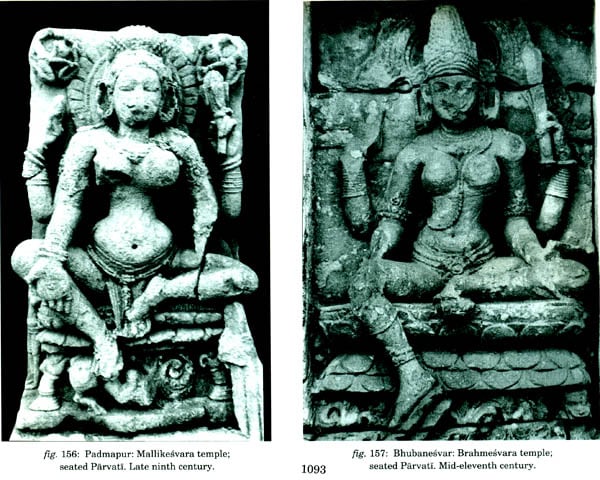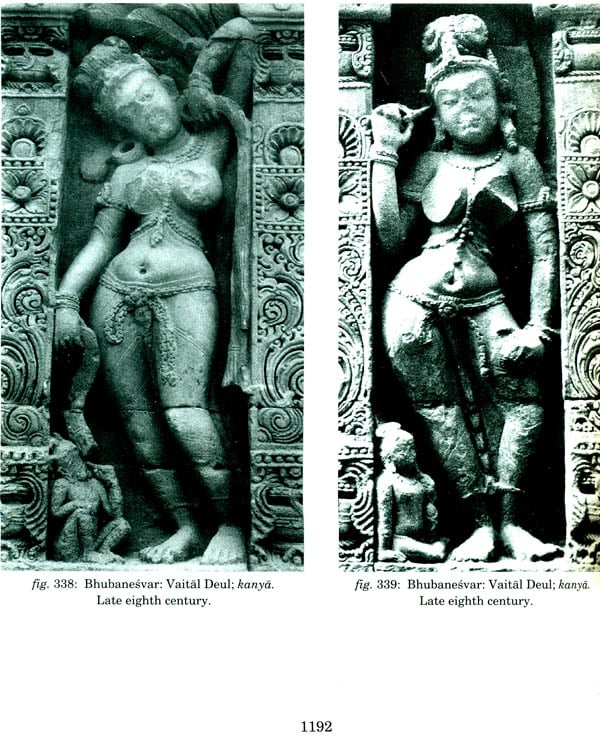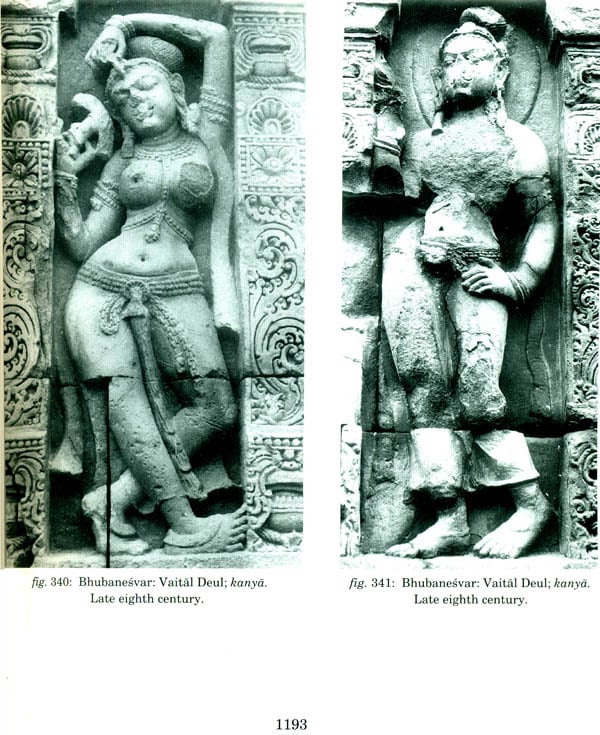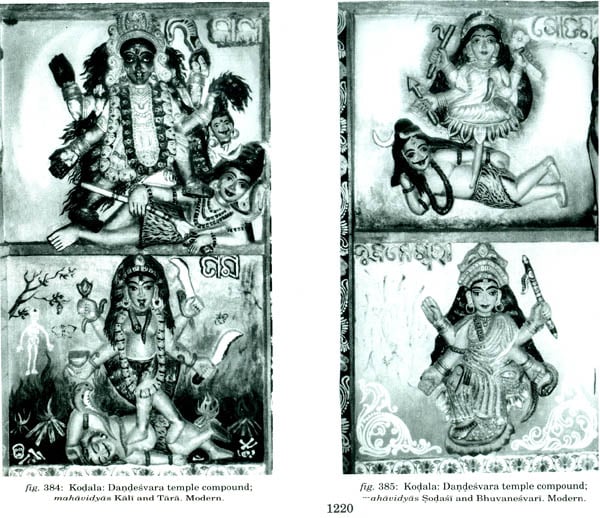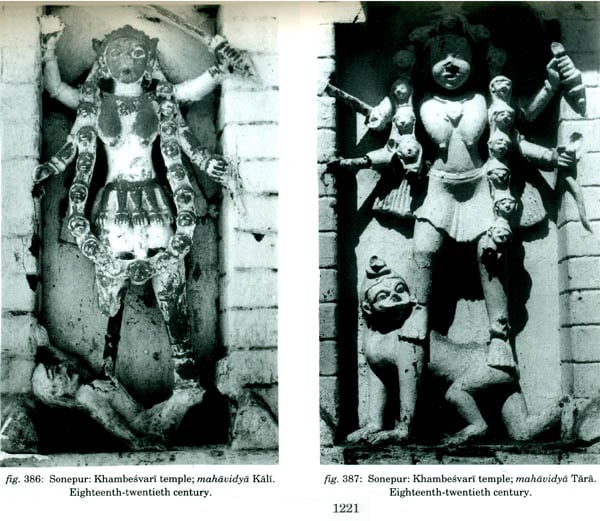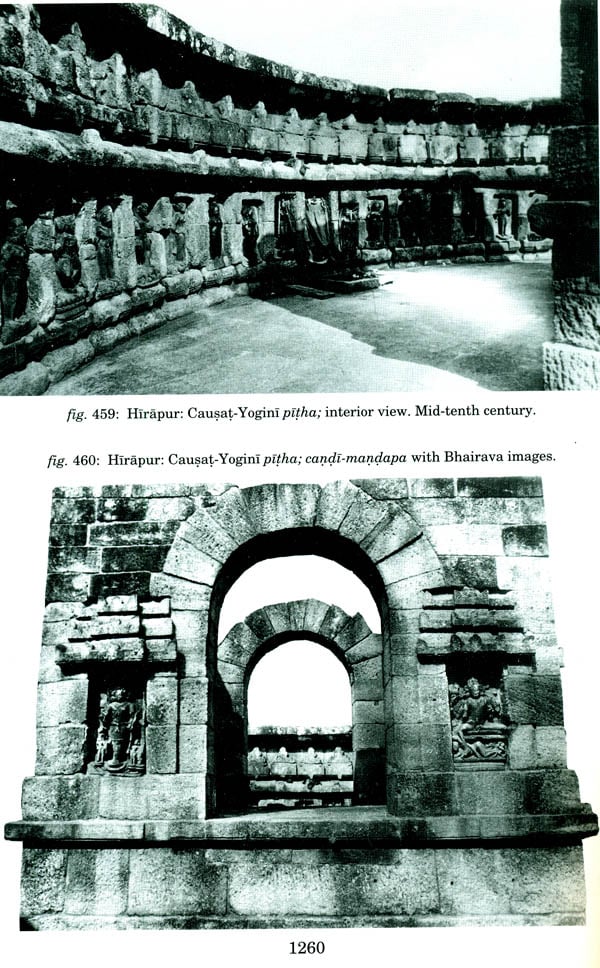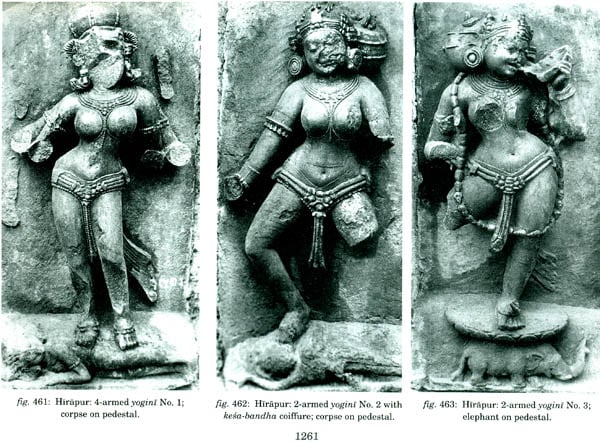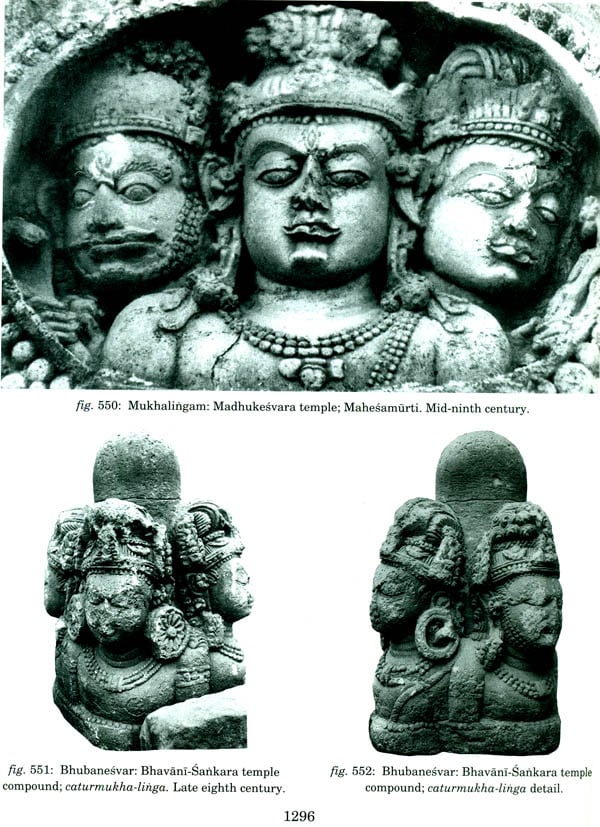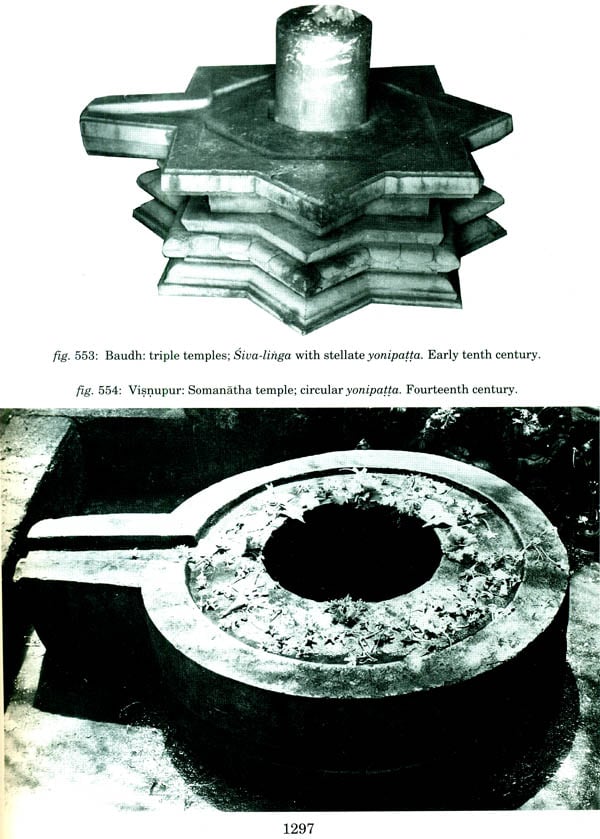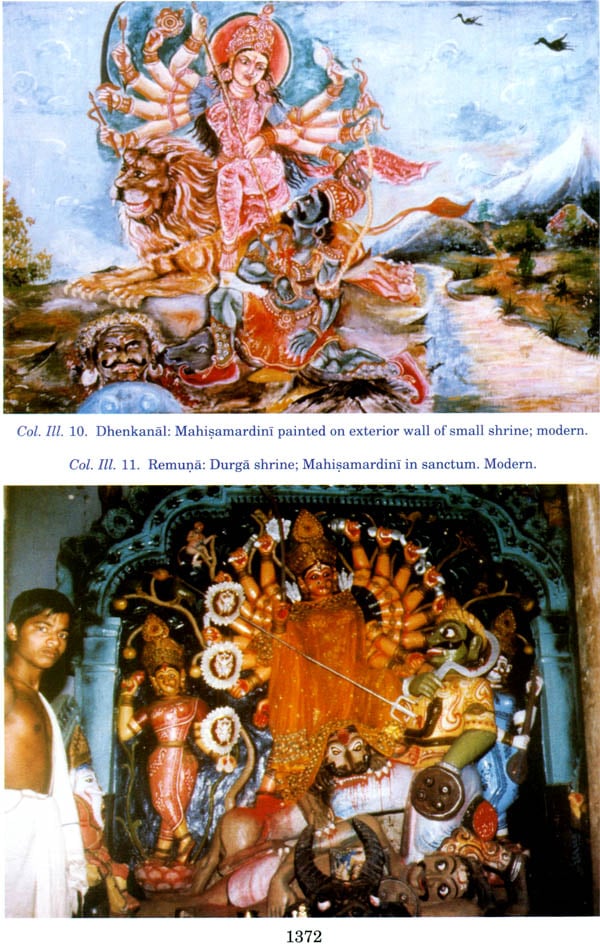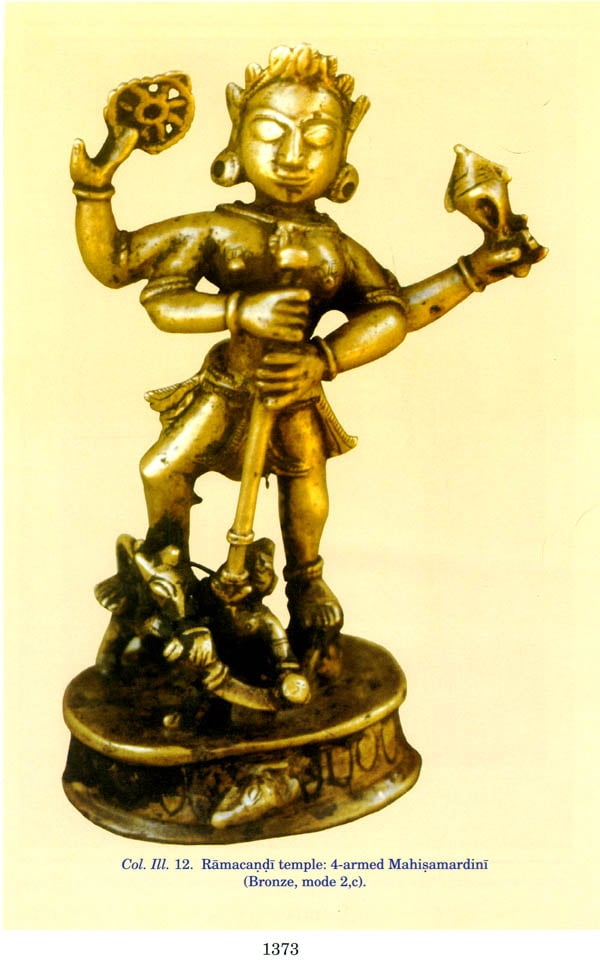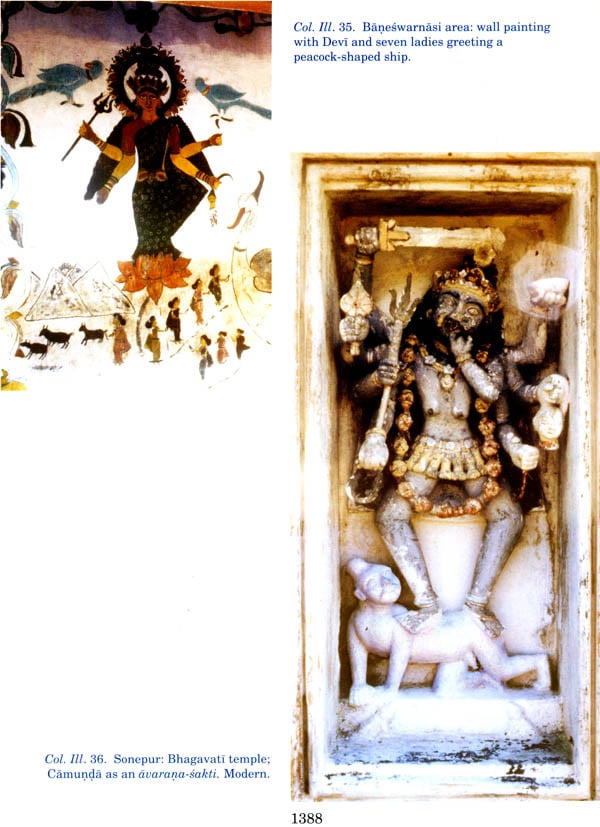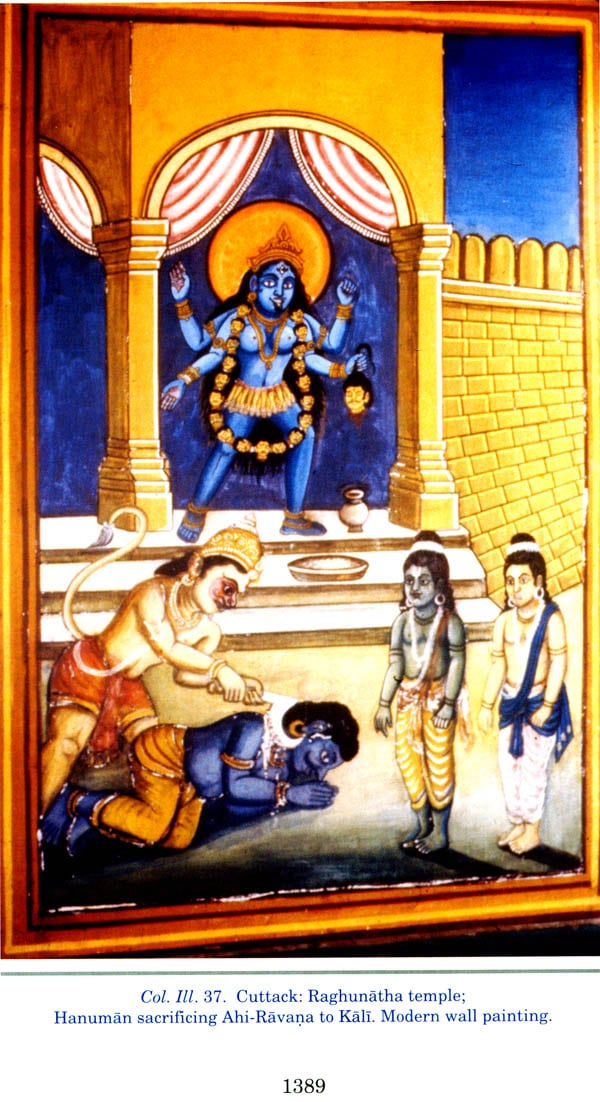
Tantra and Sakta Art of Orissa (Three Volumes)
Book Specification
| Item Code: | IDJ914 |
| Author: | Thomas Eugene Donaldson |
| Publisher: | D. K. Printworld Pvt. Ltd. |
| Edition: | 2002 |
| ISBN: | 8124601976 |
| Pages: | 1415 (Profusely Illustrated in Color and B&W) |
| Cover: | Hardcover |
| Other Details | 11.2" X 8.6" |
Book Description
Introduction
Although feminine deities, frequently but not always fertility goddesses, were a widespread phenomenon in man's early religious experience, 'the idea of female divinity was gradually neglected or rejected by many of the great historic religious traditions. Ultimate reality', C. M. Brown further pointer out, 'came to be conceived basically in terms of masculine forms (the Father, the King), or in terms of a formless and neuter Absolute'. The Hindu tradition, however,
While exceedingly creative in interpreting reality in both its masculine and neuter aspects, also developed the ritual, devotion, and theology of feminine divinity more profusely, and perhaps more profoundly, than any other major religious tradition. Hinduism thus preserves and constantly reaffirms on of man's earliest religious orientations to the universe, an orientation that particularly in the West seems to have been largely forgotten.
The emergence of Saktism and Tantrism throughout India in the sixth and seventh centuries in essence, as noted by M. Eliade, signifies a return to the indigenous spirituality, to he belief in fertility worship the magic of formulas and initiation rites, sacrifices, and, above all to the worship of the female principle. For both the Saktas and the tantrics, woman is the altar, she is the Brahman. Every woman becomes the incarnation of the Sakti; every naked woman incarnates prakrti. 'Hence she is to be looked upon with he same adoration and the same detachment that one exercises in pondering the unfathomable secret of nature, its limitless capacity to create. This religious rediscovery is also the recognition of all that is remote,
'transcendent,' invulnerable in woman: and thus woman comes to symbolize the irreducibility of the sacred and the divine, the inapprehensible essence of the ultimate reality. Woman incarnate both the mystery of creation and the mystery of Being, of everything that is, that incomprehensibly becomes and dies and is reborn.
In Sankhya philosophy, Spirit, or purusa (the male), it the 'great impotent one', the motionless, the contemplative; 'it is prakrti that works, engenders, nourishes. When a great danger threatens the foundations of the cosmos, the gods appeal to the Sakti to avert it.
Among the most important developments in goddess cults was the identification of goddesses with prakrti (nature) and with the sakti(s) or energies of their consorts, developments which not only 'allowed the goddesses to take on important cosmogonic functions, but also resulted in the ascription of the three gunas of prakrti to sakti, often identified with one or another of the goddesses'. In the original Samkhya concept, prakrti, while ever conscious, 'was solely responsible for activity; purusa was inactive and unchanging, though the superior principle, as it alone was conscious'. In Saktism, however, the active prakrti is identified with sakti (energy) herself. 'But since sakti was a conscious power, prakrti was no longer merely the activating material force but, also the power of consciousness. Bu logical extension, the male principle, purusa, would be unconscious without prakrti-sakti. With the development of the trisakti concept, whereby primordial nature is divided into three saktis according to the prevailing gunas (sattva, rajas, tamas), the Devi, as Energy/Power, becomes supreme. Once manifestation has taken place, Energy appears as the substance of everything, pervading everything:
It can be represented as the power of Siva or that of Visnu or that of Brahma. As the power of their combined form, Isvara, it becomes the Supreme Goddess (Bhagavati), the Resplendent-One (Devi) It is only when the qualityless, shapeless, motionless substratum becomes 'spotted through' by the great Energy, center of limitless energies, that the universe can be created, maintained, and destroyed.
Thus, without energy, Siva for example, is unable to create or destroy; he is as powerless as a corpse. In the Brahmavaivartta Purana (1.2.5-12), Narayana tells Narada:
As a goldsmith is unable to construct earring without gold, as a potter is unable to construct a jar without mud, so God is unable to create the world without Nature. She is vested with absolute energy; and everyone is energetic through her. Sak means grandeur and ti means valour. She who is the source of grandeur and valor is, therefore, Sakti. Bhag means prosperity, wealth and fame, the source of which all is Bhagavati. She is vested with the female organ, hence she is so called, and on this account the Supreme Lord is called Bhagvana.
In this case prakrti is the material cause of the universe, however, while Brahma or Krsna, who is self-willed, is the efficient cause. In the Devi Bhagavata Purana (1.8.31-51), Sakti alone is present in cause and effect:
The highest Adya Sakti by Her mere will creates and preserves this Universe and She is it who destroys again in time the whole Brahmanda, moving and non-moving; no one is capable to do his respective work be he Brahma, Visnu, Mahesvara, Indra, Fire, Sun, Varuna or any other person whatsoever; verily all the Devas perform the respective actions by the use of this Adya Sakti. That she alone is present in cause and effect in doing every action, can be witnessed vividly.
The term sakti, feminine in gender, had long been associated with the various male deities as their energy but in Saktism 'the energy of each god became personified as his consort, and thus if a god was separated from his consort, he was powerless and inert'. The feminine principle, Brown continues, thus was raised to pre-eminence. The triadic division of primordial nature into three saktis according to the gunas identifies each with one or another form of Sarasvati, Laksmi and Durga for the sake of creation, preservation and destruction of the universe. Thus, just as each one of the gods of the Brahmanic trinity has a Sakti or female consort associated with his particular activity, so too the other gods so that the number of goddesses and the activities with which they become associated are greatly multiplied.
At the same time, however, there is a parallel trend, less concerned with systematic schematisation, 'to identify one goddess with as many other goddesses as possible. Thereby adding to the former's glory. In contrast to the concept of male deities, however, all women are regarded as manifestations of prakrti, as indicated, and in various texts it is reiterated that all goddesses are the digits of Nature, including even the village goddesses. In that Saktism is a direct offshoot of the primitive Mother Goddess cult, so prominent a feature of the religion of agricultural peoples with each village or tribe having their own particular name for the goddess, their number is increased even more. Included among the goddesses worshipped in villages and by tribes in Bolangir district of Orissa, for example, is Mahesvari who is worshipped by the Khaduras, the bangle-makers of the district; Netai Dhovani, the caste goddess of the Dhobas, the washermen; Mahalaksmi and Kalisundari, worshipped by the Naria Gaudas, a section of the cowherd class; Dvaraseni, Patta Mahesvari, Samalai and Raktamalei, worshipped by the Sundhis, the traditional brewers of the district; Banjari, also known as Candi and Ghantaseni, worshipped by the Bhandaris, the barbers of the district; the Gandas regard Mangala as their highest goddess and also believe that she has seven sisters; they also worship Grambati, goddess of the mountain, Basumata, the earth goddess, Masandevata (Candi) and ghosts while their village deity is known as Thanapati; Udaya Paramesvari is the popular goddess among the Kosthas, the weavers of tussar cloth in the district; they also worship twenty-one types of deities of small pox of which Kolthia, Gundi, Sindhirt, Mugia, Pudamatu, Notijhara and Milimila are important; Caunrasi Samalai, Barlor-devata and Thakurani are the important deities of the Keutas, the fisherman caste while Gangamata is their water deity; the Bhulias, a weaving caste, regard Samalesvari as their highest goddess and also worship Hadmai and her consort, Dhanmai and her consort, Kansalei and her consort, Dasmati (the ten sisters) and sat bahen (the seven sisters). Even with orthodox Hindus, as evident in the sixteenth century Bata Abakasa of Balarama Dasa, the number of goddesses attending an imaginary court held by Jagannatha was twice the number of Saiva and Vaisnava delegates combined. In his essay on Saktism in the mid-nineteenth century, H. H. Wilson, overwhelmed by their sheer number, writes that the Supreme Sakti is said to have first assumed sixty (60) different forms, each of which is believed to have a great many modifications. Each of these secondary manifestation of the Sakti is again said to have taken a variety of forms, and so on almost without end.'
In that every woman incarnates prakrti, woman herself is worshipped and to insult any woman is to insult prakrti. According to Sakta doctrine, each man and woman contains within a vast latent magazine of power or sakti and the problem is how to raise and vivify sakti. Every aspirant thus has to realize the latent Female principle within himself, 'and only by becoming female is he entitled to worship the supreme being'. Even a woman or a sudra is therefore entitled to function in the role of the preceptor or guru. The aim of the Sakta worshipper is thus to realize the universe within himself and to become one with the goddess. The successive steps of the spiritual ladder, as outlined by N.N. Bhattacharyya, are constituted by three stages: pasu (animal), vira (heroic) and divya (divine):
In the first stage, the aspirant can worship any sectarian god, but he must follow all the rules of social morality, and by doing so he will be raised to the second or heroic level. In this stage, the aspirant is able to get himself initiated in vamacara and siddhantacara. For the correct understanding of the mystic rites, he requires proper training from a guru (preceptor). Now he has the right to disregard the social conventions about sexual purity and defy taboos about food and drink, since he has to look upon all women as manifestations of Sakti and to be free from all sorts of social prejudices. The ritual of pancamakara-wine, fish, meat, diagram, and coitus-performed in the proper ways under the spiritual guidance of the guru elevates the aspirant to the divya or divine standard, and in this stage he is free to get himself initiated in the kaulacara. The Kaula worshipper of Sakti is above all moral judgements, free from all worldly attachments.
Esoteric rites, in particular sexual rites, thus play an important role in the worship of the goddess, whether the aspirant considers himself to be a Sakta or a Tantra devotee. In its developed form, Bhattacharyya continues, Sakta religion became almost identical with Tantrism. In respect to sculptural art, it is difficult, if not impossible, to distinguish one from the other, or to distinguish the daksinacara from the vamacara sects. The eighth-century Vaital Deul at Bhubanesvar, for example, is generally considered a Sakta-Kapalika shrine. In Orissa, temples of all denominations Sakta, Saiva, Vaisnava and Saura - display Sakta/Tantra rituals and the worship of the Female Principle influenced all of the religions, including Buddhism and Jainism. In later periods, virtually all of the various gods are provided a female consort and in many cases, it is she who is most venerated. From as early as the eighth century, it also became commonplace to erect a special Sakta shrine within the premises of a temple dedicated to a male deity.
The characteristic features of Sakta-dharma, as outlined by Woodroffe, are its Monism; its concept of the Motherhood of God; its unsectarian spirit and provisions for sudras and women, to the latter of whom it renders high honor, recognizing that they may even be gurus; and lastly its sadhana skillfully designed to realize; its teachings.
Orissa is particularly noted as 'a land of temple' and numerous references to its great sanctity appear in various texts. In the Brahma (chs. 26, 39-40), for example, sages ask Brahma about the most excellent place on earth that bestows virtue (dharma), love (kama), wealth (artha) and salvation (moksa), and where is this most excellent of all holy centers? Brahma's answer to this inquiry, which he claims to be an ancient traditional account connected with the 'Vedas is Bharata - the Indian subcontinent. In particular, he singles out Utkala (Orissa) and its four great religious centers-Konaditya (Konarka, for the worship of Surya); Viraja (Jaipur, for the worship of Devi); Ekamra (Bhubanesvar, for the worship of Siva); and Puri (for the worship of Visnu) - considering those who stay there to be dwellers of heaven while the sites themselves yield worldly pleasures and salvation on this very earth. Similar praise, associated especially with the fame of Purusottama/Jagannatha, appears in later texts, as in the Skanda Purana (II.ii.6.27-8) where 'this land of Purusottama is said to be now Bhusvarga ('Heaven on Earth'), or in the Padma Purana (VII. 18.1-55) where, upon entering the holy site of Purusottama, all become Visnu. The great sanctity of Orissa as 'a land of temples' is also reflected in the writings of early historians, as in the case of James Fergusson, who admitted that 'there are more temples now in Orissa than in all the rest of Hindustan put together. W.W. Hunter, writing in the late nineteenth century, makes the following observation about Orissa.
Every town is filled with temples and every hamlet has its shrine In going up the Mahanadi, I noticed that each rocky islet or wooden crag that rose from its banks, was crowned, not, as upon the Rhine, by the castle of a noble, but, by a temple to some god. Even foreigners feel that they are treading on hallowed ground; and the villagers still tell how the image-breaking Muhammadans retired abashed before the sanctity of Orissa. 'This country is no fit subject for conquest, or for scheme of human ambition', exclaimed the victorious general of Akbar in 1580, 'it belongs to the gods', from end to end, it is one region of pilgrimage.
Every town is filled with temples and every hamlet has its shrine . In going up the Mahanadi, I noticed that each rocky islet or wooden crag that rose from its banks, was crowned, not, as upon the Rhine, by the castle of a noble, but, by a temple to some god. Even foreigners feel that they are treading on hallowed ground; and the villagers still tell how the image-breaking Muhammadans retired abashed before the sanctity of Orissa. 'This country is no fit subject for conquest, or for scheme of human ambition', exclaimed the victorious general of Akbar in 1580, 'it belongs to the gods', from end to end, it is one region of pilgrimage.
Sakta-Tantra cults have played a major role in the religion and culture of Orissa and even today, as evident in the Praci valley area of Puri district, the Sakta cult strongly permeates certain areas while the Jagannatha cult, in which the modes of worship synthesise Vedic, Pauranic, Tantric and tribal features, is itself of tribal origin. This religious synthesism, conspicuous throughout the religious history of Orissa, plus the relative isolation of Orissa and its strong tribal makeup, no doubt helped to foster the early development of Sakta/Tantra ideas and art. Archaeological evidence likewise suggests that Orissa must have played a major role in the development and dissemination of Tantric Buddhist doctrine, concepts and imagery. The contribution of Orissa to Vajrayana and its offshoot, Kalacakrayana, and their varied iconography, is overshelming, as Debala Mitra points out, and various sources and/or legends even attribute the origin of Vajrayana to Orissa while Uddiyana, the earliest of the four major pithas (sacred Sakta centres) mentioned in Sakta/Tantra texts, may have been situated in Orissa. Whereas most of the study in respect to the origins of Saktism and the pitha concept have concentrated on the Bengal-Assam area of eastern India, probably due to the later importance of Kamarupa and the early occupation of the area by the British, the artistic and literary contributions of Orissa have been somewhat neglected until very recently.
Aside from the few texts mentioned above that glorify the sanctity of Orissa, for the most part the country was considered outside the mainstream of orthodox Brahmanism and numerous texts actually criticize its people and religious practices. In the Mahabharata, for example, it is mentioned that the people of Kalinga (Orissa) have no religion, are without the Vedas, without knowledge, without sacrifice, and without power to assist at others' sacrifice, the gods not accepting any gift from them. In the Buddhist Baudhayana Dharmasutra, Orissa is likewise regarded as an impure country. That Orissa was considered to be a hotbed of esoteric cults, including Pasupatism and Saktism/Tantrism, seems substantiated by certain derogatory remarks in various Sind, it was regarded as unfit for performing sraddha (evening ritual). That it was equally considered to be a hotbed of vamacara rites also seems apparent in the sixteenth-century Tantrasara of Krsnananda Agamavagisvara, where the author takes a moderate view of Tantra and tries to reconcile it with the Vedic religion and the varnasrama-dharma. Konarka and Viraja are both singled out, along with several sites, as being inappropriate places for receiving diksa (initiation). This antipathy towards Orissa in this text is also evident in the classification of gurus, as the people of Odra and Kalinga, as well as those from Andhra and Kashmir, are not included in any Class. Despite this neglect and outright antipathy, modern scholars have recognized that its relative isolation served to make it 'an admirable place of refuge throughout the course of Indian history as noted by N. K. Bose:
It has so happened in the plains of North India that each wave of civilization has nearly wiped away all traces of its predecessors. But in Orissa, those very waves forced their way through a barrier of hills and jungles of uncultured tribes. Their force was broken, so that when they reached the haven, they were too weak to struggle against one another and existed in the same place side by side. The fact that the former cultures of northern India are thus preserve in Orissa in a living state has made the place so important to students of Indian history.
My major objective in this study is to present the rich and variegated fabric of the Sakta/Tantra art of Orissa with particular emphasis on the evolving iconography of individual images. In that my focus is on the image, the historical background and the religious - philosophical framework, including esoteric practices and rituals of a more abstract nature, such as nyasa rites and magical diagrams, are kept to a minimum. Unfortunately, due to the great sanctity of the Devi and the fact that Saktism/Tantrism is still a living tradition in Orissa, many of the images are unavailable for close inspection, particularly for non-Hindus. In that many of the images are now housed in modern shrines, stylistic analysis is difficult, as there are seldom exterior images contemporary with the sanctum image. This is compounded not only by the conventional practice of dressing the sanctum image in modern clothes, but also equally by the uniquely dark interiors of Orissan shrines. Late images are generally difficult to date with precision, as there is as yet no comprehensive study of later examples have been included in this study, these have been selected primarily for geographic comparison and in no way can they be considered a comprehensive study. As in the case of my three volume study on the Hindu Temple Art of Orissa, my intention here is to produce a source book that hopefully will serve as a framework upon which other scholars can expand and refine. In respect to iconography gleaned from textual sources, I have generally repeated verbatim the English translations in regard to the alignment of ayudhas. although texts frequently list the ayudhas in pairs from the uppermost set of hands downwards, in other cases they list them by which side they appear, sometimes starting from the right and sometimes from the left, though not necessarily in any specific order. In some cases there is simply a list with no preference in respect to order. In my iconographical charts, when a specific order is undetermined, I have adapted the alignment to conform to textual accounts that are more specific, as in sections of the Visnudharmottara and the Kalika Purana, or to existing sculptures for the sake of practicality and for easy comparison. It is obvious in numerous texts that the ayudhas are frequently listed next to each other in respect to functional association, rather than in a precise order, as in the case of the bow other in respect to functional association, rather than in a precise order, as in the case of the bow and arrow, the sword and shield, kartri and kapala, goad and noose, or varada and abhaya. In some texts, such as the Agni Purana, the alignment in respect toright or left hands is frequently reversed from most other textual descriptions. For the most part, in my iconographical charts, the alignment begins with the object in the principal or front right hand, whether raised or lowered, and continues (with multiple-armed images) in a clockwise direction, ending with the principal left hand, i.e., etah sumurtayo jneya daksinadhah karakramat, as prescribed in the Rupamandana (3.21a), the Agni Purana (48.1), and various other texts for the caturvimsatimurtis of Visnu. It is the Orissan images that are the major focus of the charts, however, and it is possible, considering that they are often earlier than surviving texts that they served as the original text. Sculptural images are not only more plentiful than textual descriptions but they are also less present a more comprehensive overview of evolving iconography. In that there is seldom an exact correlation with textual descriptions, it might be more accurate to assign deviations to the texts rather than to the images.
In respect to the selection of photographs in this work, I have especially concentrated on the iconographic peculiarities or on geographical location of the images, so as to emphasise the variety of forms and their widespread distribution. Where possible, I have selected unpublished or little-known works and refer the reader to volume III of my Hindu Temple Art of Orissa for further illustrations.
From the Jacket
The emergence of Tantrism and Saktism in the sixth-seventh centuries in ancient India symbolized a belief in fertility worship, worship of the female principle with the Devi/Goddess supreme as the Energy/Power-the substance of everything, pervading everything. In Orissa in particular, the sakta/tantra cults played a major role in the religion and culture of the region and this is testified by its many temples and sculptural wonders therein.
In this work, Prof. Donaldson presents a rich and variegated picture of the sakta/tantra art of Orissa, highlighting the evolving iconography of individual images. Based on largely first-hand study of the temple and their iconography and also referring the various textual sources, he deals with, in detail, the sakta mythology of the region along with its depiction in iconography. He focuses on different forms and depictions of the Goddess - the Matrkas, Camunda, Naga/Nagi, Manasa/Jaratkuru, Tara, the Mahavidyas, the Yoginis and Dakinis and images of Purusa/Prakrti, Agni/Soma and Linga/Yoni, Painstakingly analyzing the architecture of a number of temples and their images. The work abounds in photographs (more than seven hundred) revealing the variety of forms of the Goddess and their widespread distribution and provides many maps, diagrams and iconographical charts as well.
A thorough research giving attention to minute details even while studying a wide range of iconographical traditions and forms, this work will prove an indispensable source book for young as well as established scholars.
Prof. Thomas Donaldson (Ph. D.) is a leading authority on Indian art, particularly Orissan art, as he has been studying and writing on the subject for more than three decades. His works include a monumental three-volume study titled Hindu Temple Art of Orissa (1985-87), Kamadeva's Pleasure Garden in Orissa (1987), Sculptural Masterpieces from Orissa: Style and Iconography, co-authored with K. S. Behera (1998), Ornaments of Orissa, co-authored by R. P. Mohapatra (1998), Iconography of Vaisnava Image in Orissa (2001), and The Iconography of the Buddhist Sculpture of Orissa - 2 vols. (2001).
| Map of Orissa with newly divided districts | ii | |
| Acknowledgements | v | |
| Abbreviations | xiii | |
| List of Maps, Plans, Diagrams and Iconographic Charts | xv | |
| Introduction | 1 | |
| | ||
| 1 | SAKTISM IN ORISSA | 11 |
| Tribal goddesses, sacrifice, fertility and Durga-puja | 15 | |
| Aniconic form and Hinduisation | 31 | |
| Mangala, Tara and other navigation and maritime goddesses | 38 | |
| Fort goddesses (durga-devata or ista-devata) and Dasahara | 51 | |
| Sitala, Sasthi and goddesses of disease and health | 60 | |
| Sakta-pithas in Orissa | 68 | |
| Viraja (Jajpur) | 72 | |
| Ekamra-ksetra (Bhubanesvar) | 81 | |
| Purusottama-ksetra (Puri) | 87 | |
| Mahendragiri | 93 | |
| Jalesvara-pitha | 98 | |
| De-Bhogaka-ksetra (Belkhandi) | 98 | |
| Sakta temples in Orissa | 100 | |
| Bhubanesvar: Vaital Deul | 108 | |
| Bhubanesvar: Mohini, Kalika Devi and Daksina-candi Temples | 112 | |
| Baidesvar: Durga Temple | 113 | |
| Sakta temples in eighth-ninth-century Saiva temple compounds | 115 | |
| Early Sakta shrines in western Orissa: Kalahandi and Bolangir districts | 117 | |
| Khakhara temples in north-eastern Orissa: Kisorpur/Avana/Shergarh | 122 | |
| Ninth-eleventh-century Sakta shrines in Mayurbhanja and Balasore districts | 125 | |
| Ninth-eleventh-century Sakta shrines in Keonjhar and Dhenkanal districts | 129 | |
| Ninth-eleventh-century Sakta shrines in Dharmasala/Jajpur Area | 131 | |
| Ninth-eleventh-century Sakta shrines in the Mahanadi valley | 132 | |
| Ninth-eleventh-century Sakta shrines in the Praci valley | 138 | |
| Caurasi: Varahi temple | 141 | |
| Bhubanesvar: Gauri temple | 147 | |
| Ninth-eleventh-century Sakta shrines in the Kusabhadra and Daya river valleys | 149 | |
| Nine-eleventh-century Sakta shrines in southern Puri and Ganjam districts | 150 | |
| Bhubanesvar: Later Sakta temples | 154 | |
| Beyalisbati: Gangesvari temple | 157 | |
| Kakatpur: Mangala temple | 160 | |
| Twelfth-fourteenth-century Sakta shrines in coastal Orissa | 163 | |
| Later Sakta shrines in western Orissa | 168 | |
| Sonepur: Sakta temples | 173 | |
| Later Sakta shrines in eastern and northern Orissa | 179 | |
| 2 | SAKTI MYTHOLOGY AND ICONOGRAPHY | 189 |
| Destruction of Madhu and Kaitabha | 193 | |
| Destruction of Mahisasura | 200 | |
| Mahisamardini images in Orissa | 212 | |
| Mode 1: Demon in hybrid form with a human body and buffalo-head | 213 | |
| Mode 2: Demon in human form issuing from the buffalo-carcass | 217 | |
| Mode 3: Demon in Theriomorphic Form | 233 | |
| Durga iconography | 235 | |
| Simhavahini/Enthroned Durga images in Orissa | 247 | |
| Standing/Dancing Durga images in Orissa | 252 | |
| Parvati: Mythology and iconography | 256 | |
| Tapasvini Parvati images in Orissa | 261 | |
| Standing Parvati images in Orissa | 263 | |
| Seated Parvati image in Orissa | 265 | |
| Sri-Laksmi: Mythology and iconography | 268 | |
| Sri-Laksmi Images in Orissa | 280 | |
| Sarasvati: Mythology and iconography | 286 | |
| Sarasvati images in Orissa | 295 | |
| 3 | CAMUNDA/KALI AND MATRKAS | 301 |
| Matrka images in Orissa: Iconography | 326 | |
| Brahmi | 333 | |
| Mahesvari (Sivani) | 338 | |
| Kaumari | 340 | |
| Vaisnavi | 344 | |
| Indrani | 347 | |
| Eighth matrka: Nrsimhi/Mahalaksmi | 351 | |
| Virabhadra (Viresvara) | 360 | |
| Varahi: Mythology and iconography | 365 | |
| Varahi as a matrka | 368 | |
| Varahi as a presiding deity | 373 | |
| Varahi as a parsva-devata/avarana-devata | 377 | |
| Camunda/Kali: Non-matrka mythology, sacrifice and the graveyard | 382 | |
| Camunda: Iconography | 397 | |
| Camunda as a matrka | 412 | |
| Camunda as a presiding deity/parsva-devata | 417 | |
| Standing/Dancing images of Camunda | 433 | |
| Bhairava as the Consort of Camunda and as a Sakta/Tantra Deity | 440 | |
| Standing/Dancing Bhairava images | 442 | |
| Seated Bhairava images | 456 | |
| Ekapada Bhairava | 462 | |
| Andhakasura-samhara-murti | 464 | |
| Bhiksatanamurti | 467 | |
| VOL. II | ||
| Abbreviations | xi | |
| List of Maps, Plans, Diagrams and Iconographic Charts | xiii | |
| 4 | NAGA/NAGI IMAGES AND THE CULT OF MANASA/ASTIKA JARATHARU | 473 |
| Manasa/Jaratkaru: Mythology and iconography | 483 | |
| Manasa images in Orissa | 493 | |
| Astikajaratharu images in Orissa | 495 | |
| Naga/Nagi-stambhas on Orissan temples | 501 | |
| 5 | KALI/TARA AND MAHAVIDYAS | 509 |
| Avarana-Saktis on early Sakta temples of Orissa | 509 | |
| Mahavidyas: Mythology and Number | 514 | |
| Kali: Mythology and Iconography | 520 | |
| Kali as a presiding deity, parsva-devata and apotropaic motif | 539 | |
| Kali as an Avarana-Sakti and Mahavidya | 546 | |
| Tara: Iconography | 549 | |
| Tara as an Avarana-Sakti and Mahavidya | 561 | |
| Mahavidya Images in Orissa | 562 | |
| Sodasi (Tripurasundari/Srividya/Lalita) | 562 | |
| Bhuvanesvari | 573 | |
| Chinnamasta/Pracandacandika | 576 | |
| Bhairavi/Tripura and Annapurna | 580 | |
| Multi-armed Bhairavi Images | 588 | |
| Dhumavati | 591 | |
| Bagala | 594 | |
| Matangi | 596 | |
| Kamala/Sri-Laksmi | 600 | |
| River goddesses: Ganga and Yamuna | 601 | |
| Brahmanical/Sakta dvarapalas | 606 | |
| 6 | YOGINIS, DAKINIS, SAKINIS AND WITCHCRAFT | 617 |
| The Yogini cult: Mythology and Tantric Affiliation | 617 | |
| Yoginis: Number | 632 | |
| Yoginis: Iconography | 640 | |
| Yoginis: Sadhana/Rituals | 647 | |
| The Yogini cult in Orissa | 653 | |
| Hirapur: Causat-yogini pitha | 661 | |
| Ranipur-Jharial: Causat-yogini pitha | 665 | |
| Dakinis, Sakinis and witchcraft | 674 | |
| 7 | PURUSA/PRAKRTI, AGNI/SOMA, AND LINGA/YONI (SIVA/SAKTI) | 685 |
| Linga/Yoni: Mythology and iconography | 690 | |
| Ardhanarisvara: Mythology and iconography | 697 | |
| Ardhanarisvara images in Orissa | 711 | |
| Hara-Parvati: Mythology and iconography | 715 | |
| Hara-Parvati images in Orissa | 730 | |
| Laksmi-Narayana: Mythology and iconography | 743 | |
| Laksmi-Narayana images in Orissa | 754 | |
| Laksmi-Nrsimha images in Orissa | 758 | |
| Laksmi-Nrsimha seated on Sesa images | 764 | |
| Laksmi-Purusottama/Trailokyamohana images | 769 | |
| Linga-Mahisamardini-Purusottama trinity images n Orissa | 774 | |
| Baladeva-Ekanamsa-Krsna trinity images | 775 | |
| Jagannatha trinity images in Orissa | 779 | |
| Radha/Krsna and Gopmatha images in Orissa | 782 | |
| God/Consort-sakti imagery | 794 | |
| Kama-consort images in Orissa | 797 | |
| Sakti-Ganapati images in Orissa | 804 | |
| Sakti-Karttikeya images in Orissa | 808 | |
| Surya-consort and composite Surya images in Orissa | 812 | |
| Dikpala-patni images in Orissa | 871 | |
| Halahala Lekesvara Images in Orissa | 820 | |
| Jain Sasana-devi images in Orissa | 821 | |
| 8 | EROTIC AND SECULAR IMAGERY | 823 |
| The nature of woman | 823 | |
| Kumari/Kanya (virgin/maiden) and devadasi (temple dancer) | 832 | |
| Auspicious exhibitionism and personified yoni | 847 | |
| Sakta/Tantra sadhana and erotic imagery | 857 | |
| Erotic rituals on Orissan temples | 861 | |
| Mithuna/Maithuna images on Orissan temples | 873 | |
| Pleasure gardens and the pursuit of love | 877 | |
| Secularisation of the iconographic programme | 884 | |
| Guru and siksadana images on Orissan temples | 889 | |
| Royal figure on Orissan temples | 897 | |
| Glossary | 903 | |
| Bibliography | 921 | |
| Index | 937 | |
| | ||
| List of Figures and (Black and White illustrations) | 969 | |
| List of Coloured Illustrations | 1005 | |
| Figures and Coloured Illustrations | 1009 | |
| Figures | 1011 | |
| Coloured Illustrations | 1367 |
